ENVIRONMENTAL PROTECTION COMMITTEE MINUTES - MAY 11, 2016
MICHAEL E. PLOCHOCKI, CHAIRMAN
MEMBERS PRESENT: Mrs. Tassone, Dr. Chase, Mr. Burtis, Mrs. Rapp
ALSO ATTENDING: See attached list
Chair Plochocki called the meeting to order at 9:05 A.M. and detailed two announcements:
1. Informational item incorrectly listed on agenda due to his error – Finger Lakes Land Trust will speak next month, Professor Chris Somerlot will speak today regarding a comprehensive plan for Nine Mile Creek
2. Site Selection Committee for potential county-owned land along Onondaga Lake to be transferred to the Onondaga Nation will be comprised of leaders from the Nation and County government; prefers smaller committee so as not to be unyielding, reached out to several key leaders, confirmed Minority Leader Linda Ervin will be a member – wants both parties represented; excited about the process, will keep committee updated
Chair Plochocki said that the committee would be at or near capacity, if those asked agreed. However, it never hurts to have options. Let him know if other legislators are interested.
A motion was made by Dr. Chase, seconded by Mrs. Rapp, to waive the reading of the proceedings from the previous committee minutes. MOTION CARRIED. A motion was made by Mrs. Tassone, seconded by Dr. Chase, to approve the minutes of the proceedings of the previous committee. MOTION CARRIED.
1. WATER ENVIRONMENT PROTECTION: Tom Rhoads, P.E., Commissioner; Nick Capozza, Sewer Maintenance & Inspection Engineer
a. A Resolution Approving Proposed Improvements for the Onondaga County Sanitary District Consisting of the Rehabilitation of the Westside Pump Station in and for the County of Onondaga, New York
Chair Plochocki said that the public hearing for the project was discussed last month and this was the next stage.
Mr. Rhoads:
- Mr. Capozza managing project; items 1a and 1b for same project
- 2nd largest pump station, located next to I-690 Exit 7 – small brown building

-
Massive service area (pink area on map above) – several smaller treatment plants have been converted into pump stations, which pump sewer to Westside and then to Metro
-
Long force main from Village of Camillus, sewer often in pipe 48 hours or longer, becomes septic causing odors and corrosion
-
Built over 40 years ago and underpowered; Village of Solvay and Camillus infrastructure owned by municipalities, old and porous, allows tremendous amount of extraneous flow - typical dry day 6M gallons
In answer to Mrs. Rapp, Mr. Rhoads said that many of the pipes are town lines but the main is County. The yellow lines are County trunk sewers and red are County force mains. All other areas are town owned. The green line is Erie Canal Park.
Dr. Chase asked if they would get 40 years from the improvements. Mr. Capozza said not without continued investment. Mr. Rhoads said that this question (See No. 3 below) was part of the questions they received in advance from the committee. He then distributed and reviewed the following:
1) At one time was there consideration to moving this pumping station to a different location?
-
Several alternative locations were evaluated as part of the basis of design engineering report. The cost estimates for a new pump station at the alternative locations ranged between $41,500,000 and $36,800,000. It was determined to be cost prohibitive to relocate the station. The project proposed is for a comprehensive rehabilitation of the existing asset at about one half of the investment proposed for relocation.
2) If so what ever became of that?
-
Although relocation would have allowed a new station to be built without the need for bypass pumping, in the end the costs for a completely new structure, and conveyances to it, simply became cost prohibitive. The proposed rehabilitation is designed to carefully fit next to Exit 7 of Route 690, and be accommodating to the Honeywell Visitors Center and the ongoing transitions for public access in this area of Onondaga Lake. The proposed architectural perspectives will be both functional and more pleasing to the community. Odor control is also proposed for the rehabilitated station.
3) You are requesting a lot of money for these improvements, what guarantees do we have that this "new" pumping station will be more than adequate for the next 20 years?
-
The rehabilitation is designed to replace all the mechanical and electrical components. These components have a useful life of twenty years or more; ordinary wear and maintenance would still be required. In addition, the structural elements (roof, siding, concrete wet wells) will also be rehabilitated for a useful life of 20 years. Every opportunity is being made to ensure that the design and construction associated with the rehabilitation will address the challenges inherent in pump stations – including corrosion impacts from moisture, raw sewage, sewer grit and screenings, and the hydrogen sulfides associated with pumped waste to this location are considerable. Durable equipment, materials, and coatings are to be specified.
-
The rehabilitation will bring the station into compliance with all the many code compliance issues which have changed since its original 1969 construction. The rehabilitation will meet or exceed all regulatory and code requirements applicable today. Obviously if a new standard evolved in the next 20 years the County would need to address it, but we are not aware of any additional requirements being proposed. This is a robust, code compliant design.
-
The single largest risk for future additional pump station financial investment is external: extraneous flow. The station is being rehabilitated to accept peak hourly design flows at a rate of 40,000,000 gallons per day (40MGD). Average daily flows at this station are 10,000,000 gallons per day (10MGD). At 40 MGD the station will handle all current extraneous flows, as well as continued Honeywell flows, plus peak flows associated with potential future redirection of flows from a portion of the Baldwinsville Service area to Metro. Nevertheless, over 72% of the capacity of the station is designed to support extraneous flows. It is important to realize that if extraneous flows from the satellite municipal systems continue to grow completely without remedy by those municipal owners, the County is at risk for future additional investment strictly to manage extraneous flow. Strongly encouraging the satellite municipalities to manage extraneous flows - by investing in their aging pipes and manholes – remains crucial to the preservation of capacity for all WEP investments. Every drop counts.
4) Do you foresee any other projects that will have to be done to this pumping station after this?
-
This project rehabilitates WEP’s second largest pump station to meet all current and foreseeable needs. While the rehabilitation cost is significant the investment is necessary. The current station cannot meet peak wet weather flow conditions, sometimes resulting in unacceptable discharges of untreated waste to Onondaga Lake – rehabilitation is required. Perhaps the 1969 station served in a time of a bygone era of a former lake. The station rehabilitation proposed meets the service expectations of the community for sanitary service and also the modern service expectations for the public projected along trails, visitor centers, and the every expanding public access to the west shore.
Chair Plochocki asked if everyone received the questions and answers via email. Mr. Rhoads said no because he thought it would be better for all to review.
Mr. Rhoads said that the riskiest part of the pump station life was extraneous flow, which was out of their control. Currently they are using six 75hp pumps and are moving to six 150hp pumps. Mrs. Rapp asked if that would mean that the 48-hour sewage would move faster. Mr. Rhoads said that the 48-hour stuff was from the Camillus force main and would be discussed at a later date, as part of the CIP. One 75hp pump was all they need during dry weather. Fundamentally, it will be a very robust rebuild but extraneous flows are costing at least 12 to 20 times what they should be paying for asset after asset. There is no choice, as the current pump station does not have the capacity for peak flows and overflows go directly to Onondaga Lake.
Mrs. Rapp asked if they ever reached the level in which six 150hp pumps were necessary. Mr. Rhoads said, “Yes”. At 25% design, they have evaluated all incoming extraneous flows from the service area. In the future, they want to bring in a little bit of the Baldwinsville Seneca Knolls area. In answer to Mrs. Rapp, Mr. Rhoads confirmed that there would be enough capacity to do so.
Mr. Rhoads reiterated that extraneous flow was robbing the capacity for economic growth and rehabilitation costs increase due to the need for oversized pumping power - twelve times whatever is necessary. Mrs. Rapp asked if there was a plan for this. Mr. Rhoads responded that he was not present at the time Local Law No. 1-2011 passed, which talks about the ability to enforce extraneous flow conditions on municipalities. This may need revisiting, as municipalities are not making their investments and the County is paying the cost for treatment, pumping and oversizing. Mrs. Rapp asked if it would be cheaper to pay for correction of the extraneous flow. Mr. Rhoads said that it was not the County’s responsibility, so it would never be cheaper. Mrs. Rapp said that they were already paying on the other end. Mr. Rhoads said that they no longer have a choice for this case. In the long term, the County team needs to determine how to create simulation. No one wants to consolidate or merge. Therefore, each must take on the responsibility for managing their part of the system – this is critical. They have talked many times about City infrastructure and the combined sewers but the same situations are going on with suburban infrastructure. Mrs. Rapp said that this was a good place for Consensus to begin. Chair Plochocki said that many share that opinion and are looking into it. Dr. Chase agreed, noting that they had done other things together. Mr. Rhoads said that if the County took over the system they would inherit a significant number of assets, needing much capital investment. Mrs. Rapp said that she was talking about collaboration with different municipalities. Mr. Rhoads said that there are tools in place but they require municipalities to spend a nickel, i.e. sewer lining and manhole repair contracts.
- Half of relocation costs – still large number, couldn’t justify
- Robust design takes into account everything happening on the west shore – improves capacity, adds odor control and refurbishes exterior facade
In response to Mrs. Rapp, Mr. Rhoads said that the pump station would not be underground. It was a very complex site with superfund issues close to or on the site, very poor soil conditions. Mr. Capozza clarified that there was just as much below ground as there was above ground, though not everything could be below ground; submersible pumps are down about 25 feet.
Mrs. Rapp questioned if odors would be above ground. Mr. Capozza said that odors were one of the things they were trying to address. The current system does not have a filtration system and they received 4-6 complaints from DEC officials working at the Honeywell site.
Mr. Burtis questioned where the holding ponds were located in relation to the pump station. Mr. Capozza confirmed that they were to the left of Crucible, headed toward the City. Mr. Burtis asked if there were two. Mr. Capozza said that he was not sure. Mr. Burtis asked if they were providing some of the odor. Mr. Rhoads said that it was assumed. Mr. Burtis said that he appreciates what they are trying to do but there will still be an odor. Mr. Capozza said that there was an action plan for the area. Mrs. Rapp questioned who owned the pond area. Mr. Rhoads said that there was mixed ownership, he would have to come back with specifics. Mr. Burtis said that it would a shame to have the wrong expectations up front – there will still be an odor wafting from somewhere, after all the work.
In answer to Dr. Chase, Mr. Capozza said that the ponds were not overflow. Mr. Rhoads said that they were legacy waste lagoons, for lack of a better word. Mrs. Rapp asked if they were under a cleanup consent order. Mr. Capozza said that Travis Glazier would have more information on the Semet Tar Ponds. In answer to Mrs. Tassone, Mr. Capozza said that waste was no longer going into the ponds – believes Honeywell captures and treats some of the waste as part of their action plan. Mr. Rhoads said that the ground water goes to the Willis Avenue treatment plant but there has to be a hazardous waste long-term plan for the materials in the lagoon.
Mr. Capozza said that they struggled with relocating the building due to substantial risk associated with building next to something like the ponds - costs could skyrocket during construction due to unforeseen items. Mr. Rhoads said that it could be an environmental wooly mammoth.
In answer to Dr. Chase, Mr. Capozza said that construction would begin in 2017 and should complete by 2018. It is complex as they have the lake on one side and highway on the other. Mr. Rhoads said that they must also further develop several types of utilities, especially portable water. The project will have multi primes – general, electrical, plumbing, and mechanical contractors, plus outside utility contracts.
Mr. Burtis asked why the resolution was requesting $16,550,000, with a maximum cost of $18,150,000. Mr. Rhoads referenced the math supplied with the packet:

In answer to Chair Plochocki, Mr. Rhoads confirmed that the Legislature approved the cash on hand. Chair Plochocki said that this project was part of the amphitheater project at one time and asked for an overview. Mr. Rhoads said that the approving resolution contains a second whereas clause, which states a maximum estimated cost of $15,000,000. In 2014, a larger $100 million dollar Westside discussion included a $15 million dollar placeholder for this project. Chair Plochocki said that they discussed the project but only $85 million was approved, in one form or another. He thought they had voted on a resolution showing their intention to do this project - bottom line is that it was never completed and this puts the pedal to the medal. Ms. Berger said that she did not recall a prior vote but it was definitely talked about in concept. Mr. Rhoads said that the concept was discussed and there were larger discussions on the $100 million.
Mr. Burtis asked what the ramifications would be if the project was not completed. Mr. Rhoads said that if they do nothing and continue to have sanitary overflows - Mrs. Rapp interjected and asked how often overflows happen. Mr. Rhoads said that there were three in 2011 and one in 2014. Mr. Capozza said that it happens once or twice a year on average. Dr. Chase said that this cannot happen, after all the money they have spent cleaning up the lake. Mr. Rhoads said that eventually there would be fines and/or a consent judgment, which would increase costs. It will pour sanitary sewer immediately adjacent to what will be a visitor’s center and a Loop the Lake Trail, leaving a scar on the community’s vision of Onondaga County, as public participants see this has not been resolved.
In answer to Mr. Burtis, Mr. Capozza said that fines are $37,500 per day, per violation. Mr. Burtis asked when the clock starts. Mr. Rhoads said from the time the violation is received, until the issue is resolved with a consent order. Mr. Capozza said that they must report each overflow to the Sewage Pollution Right to Know website, which immediately sends out an alert to all local officials, news outlets and residents choosing to be notified. The state evaluates those on the list and issues consent orders. Mr. Rhoads said that ACJ’s get expensive in a hurry.
Mrs. Rapp asked if they had received repercussions from the DEC for the overflow. Mr. Rhoads said that they have had communications with the DEC. Mr. Capozza said that the state had been reasonable with regard to the four odor complaints, as they were satisfied with the action plans. Mr. Rhoads said the action plan included developing a capital plan to resolve these issues. He believes the DEC would respond differently, if they were not going to proceed. Mr. Capozza said that the DEC would demand immediate action if they got 4-5 odor complaints from trail bikers. Mrs. Rapp asked if that had happened. Mr. Rhoads said that the trial was not there yet but the magnitude of complaints could change soon with public use.
Chair Plochocki said that part of the $100 million dollar discussion included extending the line to Lysander and diverting some of the flow. He questioned how that plan fit into this one. Mr. Rhoads said that the new station would have the capacity to receive the flow but they would need slightly more than $3 million dollars to complete the line work. Mr. Capozza said that the additional capacity provides dual benefit. As infiltration and inflow are removed of the system, this frees up additional capacity for large industrial users like Solvay Paper Board and the NYS Fair. The fair is not a common type of operating point and they must have additional capacity to take it on.
Dr. Chase asked if the project could use local labor. Mr. Rhoads said that their work has been receiving good competition from Syracuse based companies. The project includes much utility work, which is very local. Contractors hire prevailing wageworkers, which satisfies must of the union labor. If other provisions were added, the County may not get the best price. Due to the level of local competition, he does not think it is necessary in this case. There are equal opportunity requirements, by law, as they are applying for NYSEFC funds, as well as the County’s requirements.
In answer to Mr. Burtis, Mr. Capozza said that the original pump station dates back to 1955. The current superstructure was built in 1969 and there have been multiple superficial upgrades. Mr. Burtis asked if this was the largest and oldest pump station. Mr. Rhoads said that Ley Creek was the largest. Westside was their second largest and he did not know which was the oldest. Mr. Capozza said that it was very close to being the oldest and largest.
A motion was made by Mrs. Rapp, seconded by Dr. Chase, to approve this item. Passed unanimously; MOTION CARRIED.
b. A Resolution Authorizing the Issuance of $16,550,000 Bonds of the County of Onondaga, New York, to Pay Costs of Improvements for the Onondaga County Sanitary District, Consisting of the Rehabilitation of the Westside Pump Station ($16,550,000)
A motion was made by Mrs. Rapp, seconded by Mr. Burtis, to approve item 1b. Passed unanimously; MOTION CARRIED.
Mr. Rhoads thanked the committee for their support and offered to provide any additional information needed before the full Legislature vote.
2. INFORMATIONAL: Comprehensive Plan for Nine Mile Creek
Chair Plochocki said that Nine Mile Creek was not 9-miles long but got the name for other reasons. It starts in Otisco Lake and goes through the Village of Marcellus, where it played a huge role in Marcellus history. It continues through the Village of Camillus and goes into Geddes, ending near the amphitheater. It crosses the old Erie Canal and is considered one of the best fishing creeks in the state. The Nine Mile Creek Conservation Council is a group of concerned citizens who have done an enormous amount of work, including preservation issues, with regard to the lake and have spoken as experts. Mr. Somerlot is a member of the Nine Mile Creek Conversation Council and a professor at SUNY-ESF. The Council, along with ESF students, put forth an unofficial comprehensive plan for the future of Nine Mile Creek - unofficial in the since that it could be used as a template for municipal governments to draw aspects of it, or the entire amount, to adopt their own comprehensive plan.
Mr. Somerlot provided copies of the plan (On file with Clerk) and presented the following:
- Vice president of Nine Mile Creek Council – grassroots 501c3, nonprofit, apolitical
- Day job - board of resources engineer for local consultant and visiting professor for ESF Engineering department

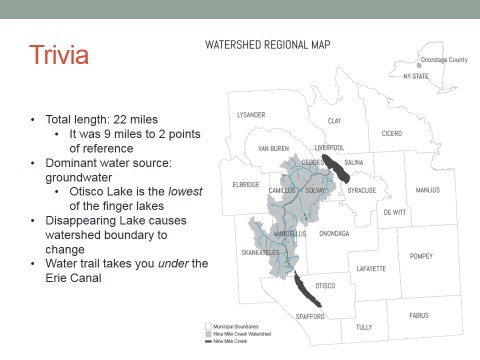
-
Runoff from Pumpkin Hollow wetland goes to Onondaga Creek when low, at certain level shots off toward Nine Mile Creek therefore water fluctuates – very unique
-
Water trail built along creek by the Council – put in docks, signage and trail maps, recognized as official water trail by DEC, goes underneath Erie Canal and aqueduct, very unique to the region
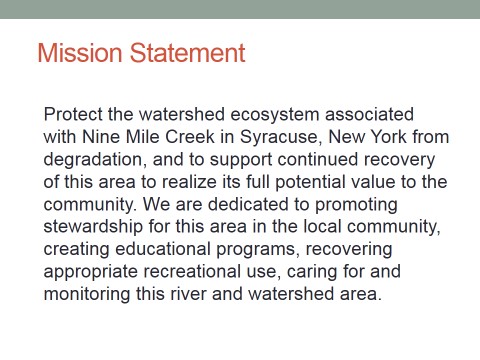
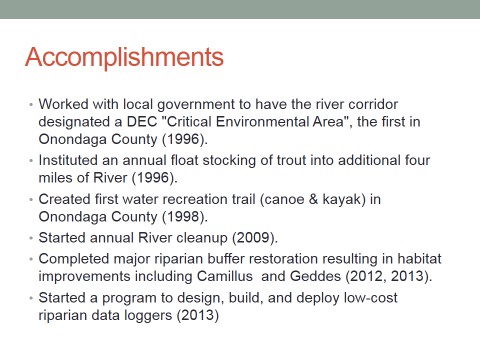
- Group formed in mid-90’s by ESF professors and DEC official
-
Critical Environmental Area designation mandates long form environmental statements for all construction – provides level of protection for the river; maintain buffer restoration green infrastructure with volunteers; non-point source pollution largest contributor of phosphorus to Onondaga Lake – reduction efforts must focus on this source, difficult to monitor and track, data may help determine best effort; small list of accomplishments – much more going on

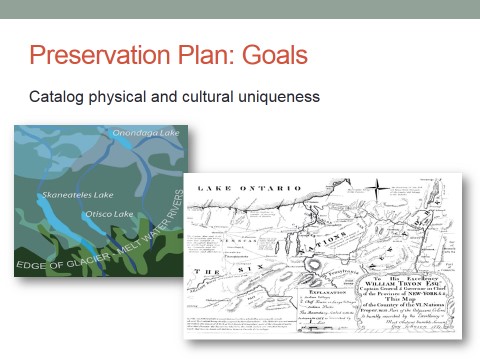
-
8 member board primary membership, never struggled with funding – received funds from Honeywell, GE, OLP and GLI grants; partner with OCSWCD, Walton League and Finger Lakes Land Trust
-
Reached out to 5th year Landscape Studio to make Nine Mile Creek watershed their project, used funds from scrap metal cleanup and students efforts to create plan
-
Creek runs north, glaciers cut through valley, left many hanging waterfalls and a disappearing lake, Onondagas came to the region specifically for the water resources
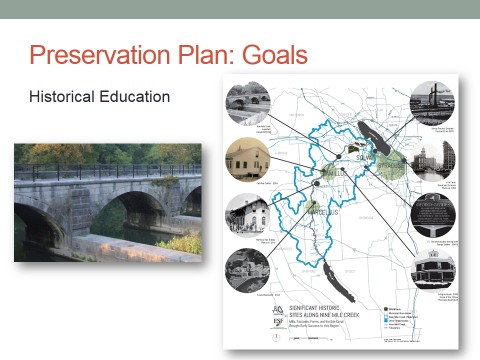
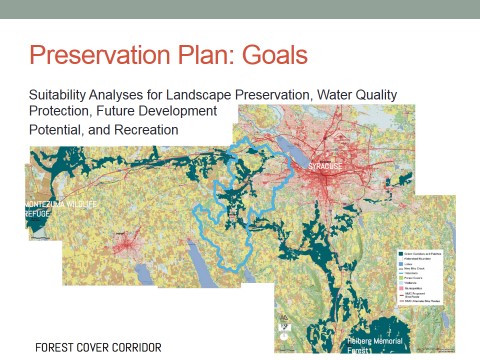
- Huge cultural history to keep up to date combined with historical uniqueness
- Many vacant or undeveloped parcels present opportunity for public use
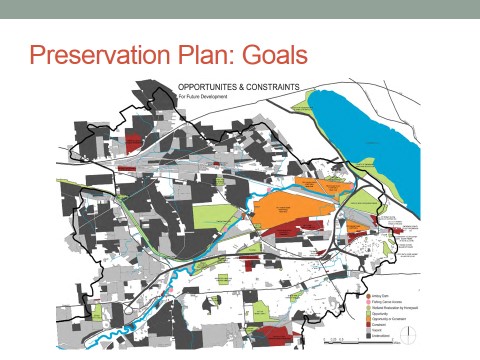

- Preservation plan used to drum up interest and take people to the next step
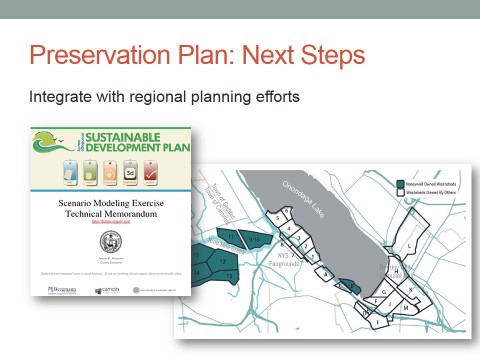
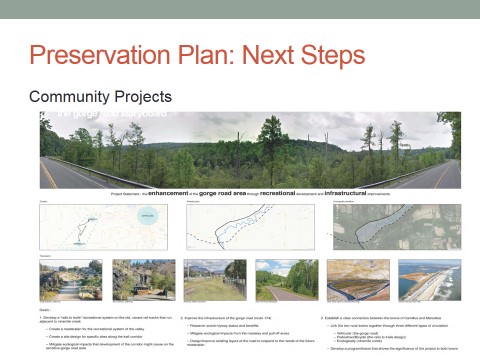
- To capitalize plan must work closely with County Planning and Honeywell
- Community project examples: Creek Walk extension, improved biking and fishing access
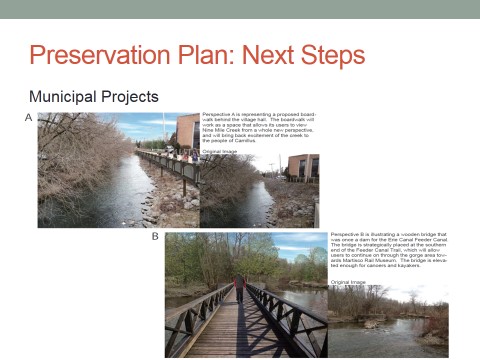

- Rendering’s show possible projects
- Environmental projects may improve habitat for endangered species
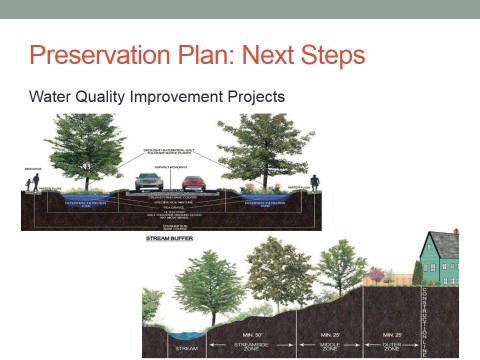
-
Holistic analysis of the watershed – determine where best efforts and funding would go, develop capital improvement plan for low hanging fruit - projects with most benefit and where limited volunteer base can best be applied
-
Presenting plan to OLWP and Counsel on Health – document has been in review for 1 year with ESF scientist, DEC and others; will seek funding and partnership with existing network to produce next steps
Chair Plochocki said that the plan was detailed and very impressive.
Mrs. Tassone asked for an explanation of the disappearing lake. Mrs. Rapp asked how often it happens. Mr. Somerlot said that it had not happened much in recent years. The area is a wetland that normally drains away east of Onondaga Creek. When incoming water drives the water up to a certain level an exposed crack on one side of the bedrock then scopes water up from the bottom and sucks it into the ground. The lake disappears overnight by siphon action, similar to flushing a toilet. In recent years, trash has gotten into the area and divers have been unsuccessful in attempting to remove it – very dangerous endeavor. In the 70’s a tracer die study showed that ground water makes it way to Nine Mile Creek by Marcellus Falls. There are underground cracks in the limestone base bedrock where water is sucked out of the disappearing lake and eventually feeds into all the places where they see water falling. Most of the Nine Mile Creek water reaching Onondaga Lake is from these ground water sources. This is what makes for fantastic fishing – clean, cold groundwater regulates the temperature, is silk free and low on runoff. Per the DEC, there are 500 fish per acre - one of the most productive trout streams in NYS.
In response to Mrs. Rapp, Mr. Somerlot confirmed that there was public access for fishing. They also worked with the DEC to identify new parcels a few years ago, i.e. Amboy Dam parcel was owned by OCWA, negotiated transfer to DEC, now all public access fishing.
- Plan easy to read and interesting, will continue presenting to various groups, mainly meant to generate interest in Nine Mile Creek
Chair Plochocki thanked Mr. Somerlot for the presentation and all the work put into the plan.
Chair Plochocki asked if members had anything further. Dr. Chase asked if there was a plan to look at other options for waste management. Chair Plochocki said that there was not an actual plan. Dr. Chase asked if they could make a plan. Chair Plochocki said that she was asking to put together a plan, to make a plan, and the coming months may be an opportune time. Mr. Donnelly left OCRRA and Don Lawless is temporarily serving as executive director. Since OCRRA is in a state of flux, he would rather wait until there is a new leader. In the meantime, Mr. Lawless could provide an update for the committee.
The meeting adjourned 10:15 A.M.
Respectfully submitted,

KATHERINE M. FRENCH, Deputy Clerk
Onondaga County Legislature
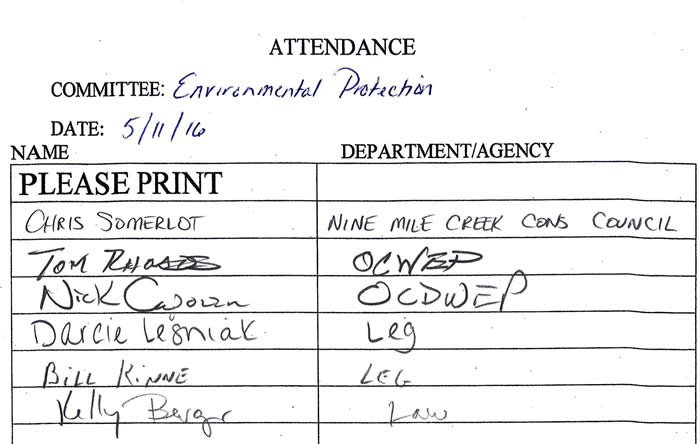
* * *
COUNTY FACILITIES COMMITTEE MINUTES – MAY 11, 2016
JUDITH A. TASSONE, CHAIR
MEMBERS PRESENT: Mr. Shepard, *Mr. Dougherty, Mrs. Rapp, Dr. Chase
ALSO ATTENDING: See attached list
Chair Tassone called the meeting to order at 10:33 a.m. A motion was made by Dr. Chase, seconded by Mrs. Rapp to waive the reading of the minutes of the previous committee meeting. A motion was made by Mrs. Rapp, seconded by Mr. Shepard to approve the minutes of the proceedings of the previous committee meeting; MOTION CARRIED.
1. TRANSPORTATION: Brian Donnelly, Commissioner
a. Amending the Design (Scoping I-VI) and Right-of-Way Incidentals Phase of Allen Road (CR 205) Paving Project, PIN 375461 by $100,000, and Increasing the Authorization to Pay in the First Instance 100% of the Federal Aid Eligible Costs by $80,000 ($80,000)
-
Existing project for Allen Road repaving; north of Taft to south of Bear; additional design funding; archeological review
-
1a report mandated by NYS; if there is anything of historical significance, then mandate a 1b report; did not budget for 1b report, but NYS found things necessary to explore; needed to do 1b
Mr. Rauber stated there are historic structures over fifty years old, and also remnants of pots and pans that were buried. Field work and documentation was done. Mr. Donnelly said an archeologist was brought in.
Mr. Donnelly continued:
-
Underdrain in area; corrugated metal pipe rusting out that needs to be replaced; sidewalk on project; other areas also warranted, so they are being added; by the school
-
Rural areas have ditches, but this has catch basins and underdrain; drainage pipe put in 25+ years ago is corrugated metal that is rotting out; replacing with plastic pipe
-
Timeline: Finish design this year; bid this winter; construction 2017
A motion was made by Mrs. Rapp, seconded by Dr. Chase, to approve this item. Passed unanimously; MOTION CARRIED.
b. Amending the 2016 County Budget to Fund in the First Instance 100% of the Federal Aid Eligible Costs at a Maximum Amount of $260,000 for the Design (Scoping I-VI) and Right-Of-Way Incidentals Phase of the Old Route 57 Paving Project, PIN 3755.82, and Authorizing the County Executive to Enter into Agreements to Implement the Intent of this Resolution ($260,000)
- New fed aid project; design portion for paving Route 57; from Calder Court north to just shy of Route 31
*Mr. Dougherty arrived at the meeting.
- 2 fed aid projects in design for Rte. 57; no major work on Rte. 57 in 20-25 years; large portion from Liverpool north
-
Calder Court is north of Bayberry; used to be State Route 57, but state gave to County in ‘50s or ‘60s; actually County Route 91, but known as 57, so did not change name
- This initiates design of project
A motion was made by Dr. Chase, seconded by Mr. Dougherty, to approve this item. Passed unanimously; MOTION CARRIED.
2. FACILITIES MANAGEMENT: Duane Owens, Commissioner
a. A Resolution Authorizing Design Expenses in Connection with Improvements to Public Facilities in and for the County of Onondaga, New York, at a Maximum Estimated Cost of $550,000, and Authorizing the Issuance of $550,000 Bonds of Said County to Pay Costs Thereof ($550,000)
b. A Resolution Authorizing the Construction of Improvements to Various Public Facilities, in and for the County of Onondaga, New York, at a Maximum Estimated Cost of $4,969,000 and Authorizing the Issuance of $4,969,000 Bonds of Said County to Pay Costs Thereof ($4,969,000)
Chair Tassone stated for the record that the Capital Plan, and anything to do with the campus, will exclude Carnegie Library.
Mr. Owens reviewed the projects in the Capital Improvements Plan:
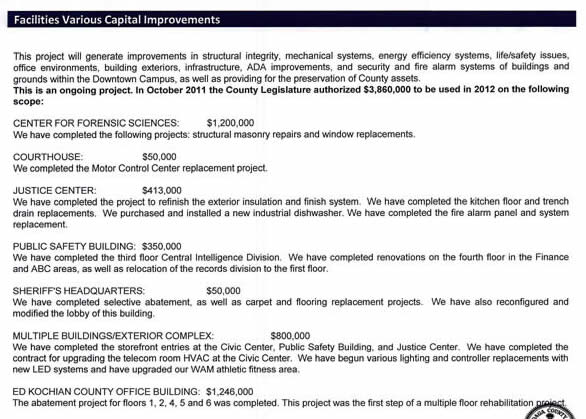
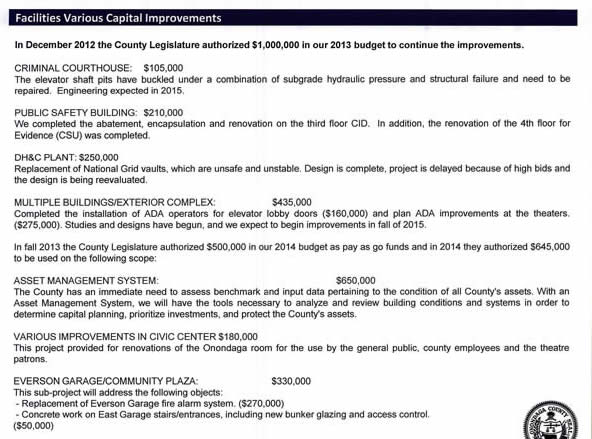
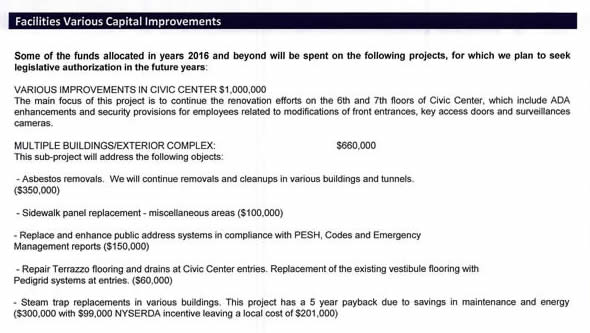
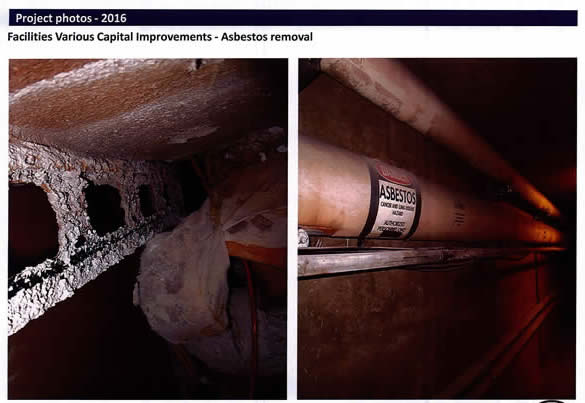
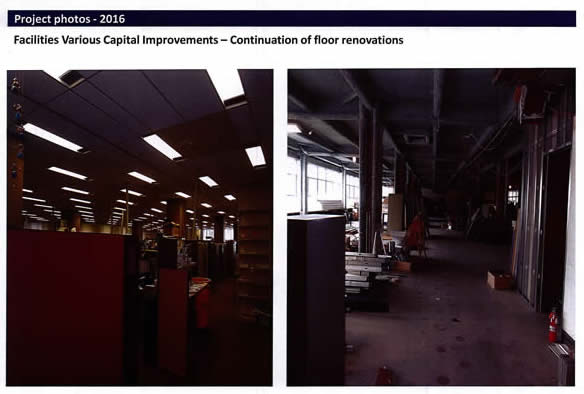
Mrs. Rapp was concerned with asbestos getting wet from the leak. Mr. Dougherty commented that asbestos is most dangerous when it is dry, and Mr. Owens agreed. When abating asbestos, it is wetted down.
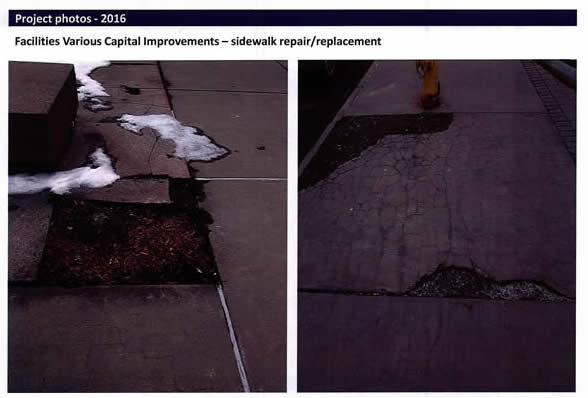
Mrs. Rapp asked if the sidewalk replacement is in conjunction with the Syracuse University (SU) improvements, and if it is in the same area. Mr. Wixson responded it is not part of the connective corridor. Chair Tassone commented that the County is only overseeing that, and does not have money into it. Mr. Owens said this is for the downtown buildings, not the connective corridor. The Everson Museum is the County’s responsibility. Mr. Owens stated SU is putting in a kiosk, a fruit tree project and crosswalks, but not doing the sidewalks. The sidewalk project is starting now with a term contractor, and the Everson Museum sidewalk is a priority. Mr. Wixson believes they started excavating. Mr. Owens responded to Mrs. Rapp that it benefits the County to repair the sidewalk, and deal with the City after. If someone fell, they could sue both the County and the City, and Mrs. Berger agreed.
Mr. Owens:
- 6th floor ~60% complete; initially planned to renovate 7th and 8th floor; created 15th floor swing spot for renovations
-
After abated County Office Building and renovated 1st and 5th for Probation; moved Probation off of 6th floor Civic Center
-
Plan to renovate 6th floor while it’s open; when done, employees on 7th will move to 6th; then renovate 7th floor
-
65% through 6th floor construction; will start planning process of moving 7th floor offices down; start way in advance so when done with construction, can coordinate moving materials and employees
- Funding from Capital Improvement to start 7th floor construction
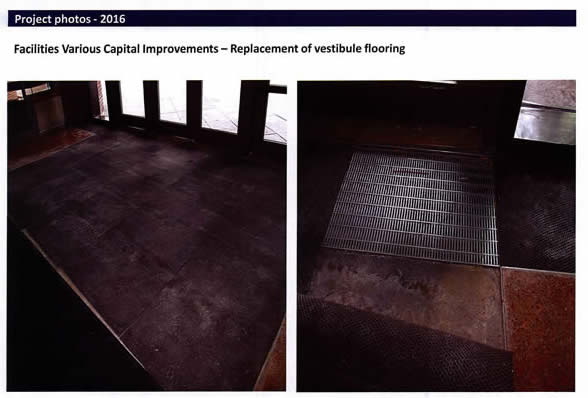
Mr. Wixson replied to Mr. Dougherty that the picture is the main lobby entrance on Montgomery between the theater and the Civic Center. Facilities will keep one or two doors open. Mr. Dougherty asked how long it will take. Mr. Wixson explained it is to replace rubber inserts that have fatigued, so they will put in a more metallic and abrasive surface system. The plan is to take the drain out, which is more work than anything else. Mr. Wixson responded to Mr. Dougherty that it will take a couple weeks. Mr. Owens commented that there will be safe guards for people, so they use the proper door, and barricades so no one trips over the construction. Also, Facilities will make sure the theater is not in use. It will be coordinated to work over weekends, partially at night and minimize the impact on constituents.
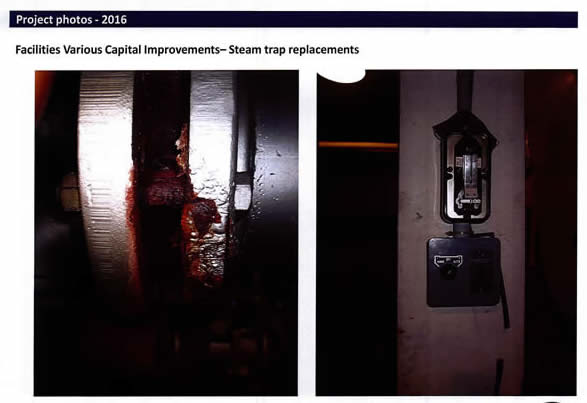
Mr. Owens:
- Steam traps lose heat and water when not operating properly

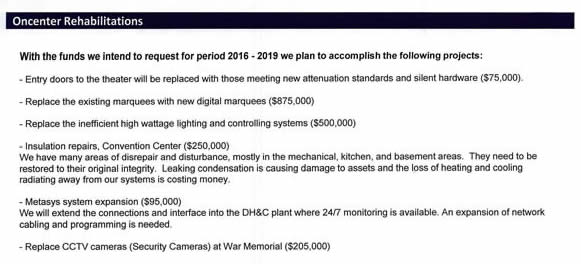
Mr. Owens:
- Oncenter Rehab – in past, authorized $1.5 mil ($500,000/yr); requesting another $1.5 mil; $500,000/yr starting 2016
-
War Memorial marquee on Montgomery and State needs replacement; $875,000 est. cost; more up to date digital
-
Lighting control in ballroom of Civic Center; lighting control system obsolete; run risk of blowing out; high wattage lights with intense heat that burns walls; switch to more energy efficient
Mr. Dougherty asked where the lights are, and Mr. Owens responded in the Civic Center up high by the ceiling of the entry lobby. The replacement will be LED lights. Mr. Wixson said the exhibit halls A and B also have the same lighting. The existing lights are very hot and expensive to run, and the new technology makes sense. Facilities tries to grab every credit possible through NYSERDA or National Grid. Mr. Dougherty asked if this was done recently at the War Memorial, and Mr. Wixson and Mr. Owens responded yes. Mr. Wixson said it made a big difference. It is quite a savings, and it has been done in the libraries and garages.
Mr. Owens commented that every time one of the current lights blows, Facilities has to rent a lift, which is rented by the week. Mr. Owens responded to Mrs. Rapp that the replacements will hang in the same place, but LED’s are more modern, require far less maintenance and are less costly. The lights may cost more upfront, but there are savings on maintenance and electricity; which far outweighs the cost difference. Mr. Dougherty asked if that’s what the $500,000 is for. Mr. Owens said that, and the ballroom lighting and control system.
Mr. Owens stated the security cameras in the War Memorial need replacement. The system in the lobby is antiquated, and Mr. Owens thinks the upgrade could be done for about $205,000.

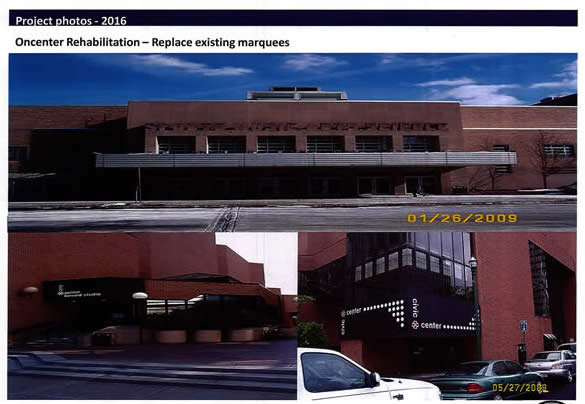
Mrs. Rapp asked about the funding, and Mr. Owens responded:
- 3 pots of money: (1) $500,000 Facilities has control of; (2) Capital pot of $250,000; (3) Facility Fees
- Sit down and make list of all projects and prioritize; based on priority, use those funds to get projects done
- $500,000 will not get marquees - $875,000; some of $500,00, plus capital money from previous account and may use another account
Mrs. Rapp thought the facility use fee would cover the marquee. Mr. Owens responded it helps cover it, but there is so much that needs to be done. Facilities is trying to do projects based on their payback, so some of the funding will be used for these projects. Mrs. Rapp is struggling with the capital fund plus facility use fees, and adding in County tax dollars for the Convention Center. Mrs. Rapp did not know that was part of the deal. Mr. Owens does not know how much the facilities fees are, and said SG would have the accounting to know how the facilities fees are being used. Chair Tassone asked Mr. Owens to get the information tomorrow. Mrs. Rapp thought that was how it was divided when it was negotiated. Mr. Owens is not sure, as he was not part of the negotiations. Mr. Dougherty commented it does not change most of what Facilities is trying to do. Most of the renovations and updates would not be covered, so it is just the OnCenter.
Mr. Dougherty asked if all of this was planned within 2016, and Mr. Owens responded yes. Mr. Dougherty asked if the work would be done by the end of this year. Mr. Owens replied a good portion will be done, but not all. Some will be based on other things getting completed. Mr. Dougherty asked which item will take the longest to finish. Mr. Owens answered the Civic Center masonry improvement, which is for the 7th floor. The 6th floor needs to be completed, then everyone needs to move from the 7th. It will carry over into 2017, and Mr. Wixson agreed. Mr. Dougherty asked, with the exception of that or a schedule slip, everything should be done in 2016. Mr. Wixson replied everything will be in, and there will be some closeout in 2017. Mr. Owens commented that the ballroom lighting might be tricky as it has to be coordinated with events going on. Mr. Owens agreed with Mrs. Rapp that summer is not as busy, so if it is approved now, Facilities could start the bidding process. It would be great to get it done in the summer months, because it’s tough in the winter months.
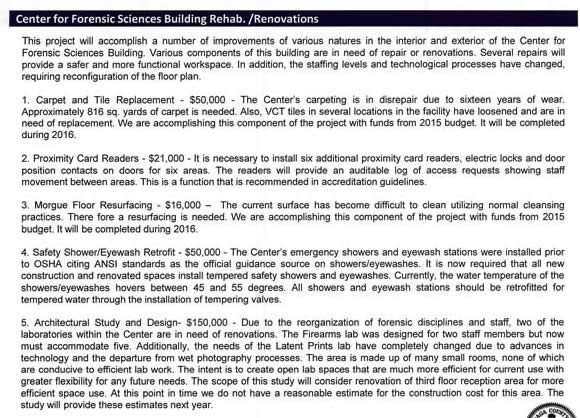
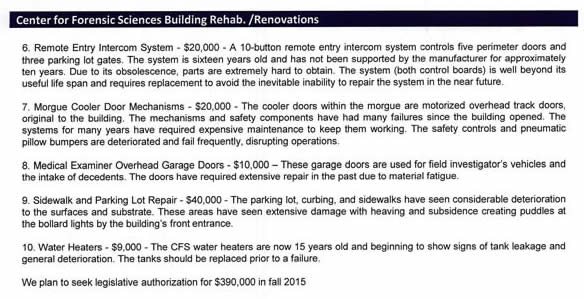
Mr. Owens:
- Request changed: 2015 asked for $390,000, now asking for $335,000; able to get some projects done with prior money and operating costs
Mr. Petrela responded to Mrs. Rapp that the individual numbers add up to a little less than $335,000, because issuance fees are included in the total.
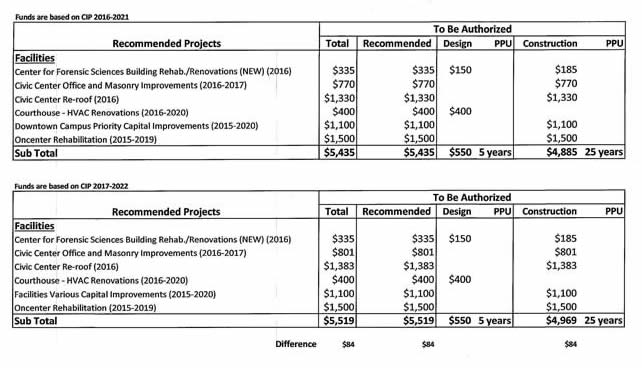
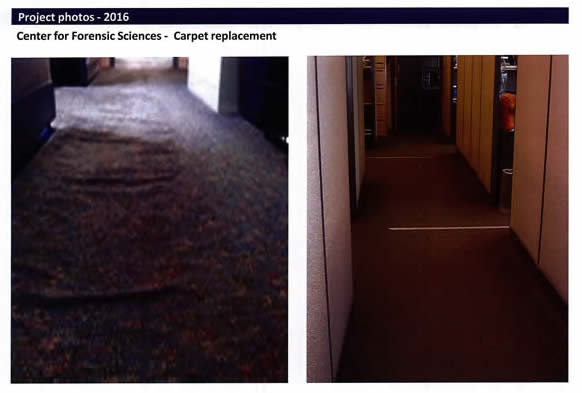

Mr. Owens:
- Carpet replacement; door key entry currently, but will be card access to know who went in
Mr. Dougherty asked if it will require a pin. Mr. Wixson responded it will be like a badge or fob, and it will not ask for a pin code.

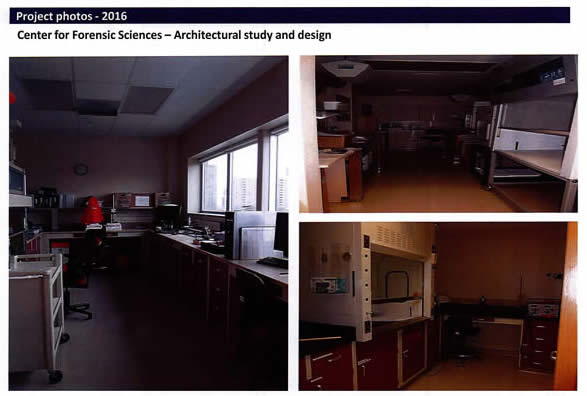
Mr. Owens:
- $150,000 to redesign office space; department grown since renovating; put together design that suits current operation
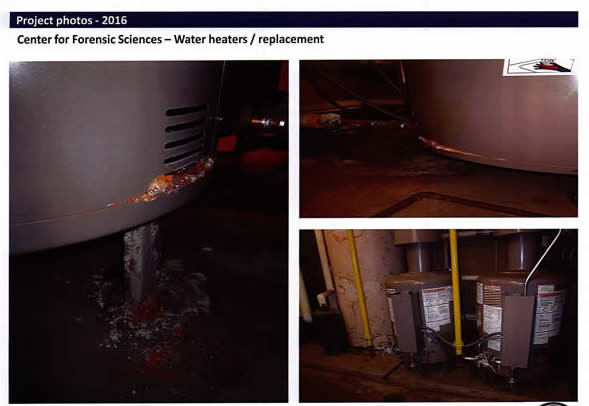
Mr. Wixson responded to Mr. Dougherty that the water heater is from 1998.
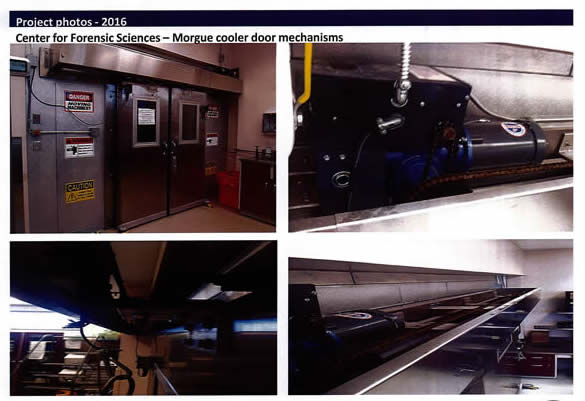
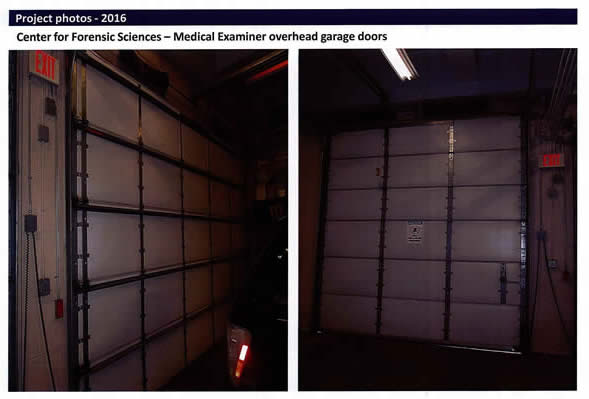
Mr. Owens stated the morgue door jamb broke, and needs replacement; as well as the overhead garage door. Mr. Dougherty asked what is wrong with the garage door. Mr. Wixson replied the chain needs replacement, the gears are grinding and spring sprockets are fatigued. Mr. Wixson is not sure the panels can be saved as there are dents in them from 20 years of use.
Mrs. Rapp asked about the status on Carnegie. Mr. Owens hopes it does not sit. Dr. Chase asked if there have been any bites on renting it, and asked about the timeframe. Mr. Dougherty responded there was a timeframe, and it has to be getting to the end of it. Mr. Owens stated an RFP did go out, and the time for response has come to an end. Mr. Owens will check with Purchasing and Ann Rooney about any responses. Mr. Dougherty asked if there was any interest, and Mr. Owens replied there was no preliminary interest. Mr. Dougherty said the RFP that went out was restrictive with a lot of stipulations regarding who could buy it, and what use it would be. It also asks about seeing business plans, which Mr. Dougherty would not care about if he were selling it. Dr. Chase asked if it has to do with the original stipulations on the building, and Mr. Dougherty said that was not mentioned. Dr. Chase asked if the County is done with any stipulations from the Carnegie Foundation, and Mrs. Berger responded she will have to look into that. Chair Tassone does not think there are any stipulations.
Mr. Owens said this is a carryover from 2015. Normally this would have been presented in the fall of 2015, and authorized to do in 2016. Chair Tassone asked Mr. Owens to give everyone a copy of the Status of Capital Projects (On file with the Clerk). Mr. Owens responded to Mrs. Rapp that typically this is presented at budget, but that process has changed. Facilities is asking for authorization for this year, so they will start some of these projects immediately. Mr. Owens replied to Mrs. Rapp, that he expects these to be done this year, and will be back in the fall of this year to request for next year.
Mr. Owens stated the National Grid vault between the Justice Center and the Steam Station is deteriorating, and he would like to get that done while it is concrete season. The vault is the County’s responsibility to maintain. Mr. Wixson commented that is where National Grid service comes in for the County, there are transformers down in the vault, and it is on County property. Mrs. Rapp said it’s like a fuse box in a house, and Mr. Owens agreed. Mr. Wixson stated Facilities had to repair one for the Court House where the hot dog vendor is. National Grid has to do maintenance only when it is in the sidewalk easement.
Mr. Owens said the timing of bids for construction is important as far as a cost perspective. If the timing is not right, the competition is not there, because they already have other projects (like schools). Mr. Owens stated the numbers they bring to the committee are just estimates. Mrs. Rapp asked if the deadline was missed, and Mr. Owens said not for the things needed to be done. There is not a lot of concrete work in schools, and the ballroom lighting is a specialty. Mr. Owens would like to get this in for construction season. Mrs. Rapp said it’s May, almost June, and asked why the committee is seeing this now instead of back in January. Mr. Owens responded Facilities was not ready, and initially came over in February. Mr. Owens replied to Mrs. Rapp that it is the same project list, and there were questions at the last meeting regarding the Carnegie building.
Chair Tassone said that the resolution for 2a does not include the description of all of the projects, but it will, and asked for a motion to approve 2a. Mrs. Berger will have to reach out to Bond Counsel after drafting the language to see what can be put in. Mrs. Berger responded to Chair Tassone that the committee can vote on the intent to amend the resolution, and stated it is not changing the scope of the project at all. Mrs. Berger will work with Facilities and Bond Counsel to see if they can make the change. Chair Tassone asked if the committee should wait to vote, and Mrs. Berger said they can vote on it. Mr. Dougherty feels the questions Mrs. Rapp asked can be answered as early as tomorrow when Facilities will meet again. Mr. Dougherty would like to wait. Chair Tassone said the committee will hold off.
Chair Tassone asked Mrs. Rapp to reiterate the questions she would like answered. Mrs. Rapp stated it was reference the capital fund with the OnCenter, and why Facilities is using County dollars. Mrs. Rapp clarified for Mr. Owens that she wants to know about the capital fund for the OnCenter and the facility use fee, which is supposed to handle capital improvements at the OnCenter. Why is Facilities using County tax dollars on top of those funds? Mr. Wixson responded that the facility use fees cover equipment investments like sound systems, curtains or wall dividers. Lights are also included, but the ballroom lighting is a large enough project that exceeds the facility use fee in time period. Some of the fund is designated for the theater, as there are five properties that the fee is used for. Mrs. Rapp stated the $250,000 capital money is in addition, and Mr. Wixson agreed. Mrs. Rapp said it seems there are three sources of funding, and asked why use the third versus spacing out projects to use only the two. Mr. Owens responded that some of the projects total costs far exceed the three funds. There are some things that will not get done, because there is not enough funds. The marquee and the ballroom lighting add up to $1.375 million. The $500,000 plus the $250,000 only equals $750,000, which is still not enough for those two projects. Mrs. Rapp said it’s a policy question to do projects of that magnitude. Mr. Owens stated the ballroom lighting project needs to be done, otherwise there’s the potential of not having anything there. The marquee also needs to be done. Mr. Dougherty said the marquee makes the whole building look old, and has a big effect on the appearance. The marquee on the War Memorial looks outdated versus the marquee on the theaters which looks modern. Mr. Owens agreed with Mr. Dougherty that the marquee has been talked about for a long time, and this is the first time there was a price attached. Mr. Owens said it a revenue generator, and attracts people to use the building. Dr. Chase stated there are two marquees, and asked if they can be redesigned to be smaller. Mr. Owens replied that they cannot do that, because there are limitations to what can be done to the exterior of the building. The size and height cannot be modified. Mr. Owens answered Mr. Dougherty that it will be digital, and on the same structure.
Mr. Dougherty said the new lights and scoreboard (at the War Memorial) made a huge difference, it is brighter, feels newer, and the scoreboard looks more modern. Mr. Dougherty believes the marquee will have the same affect. Mr. Owens asked if anyone has seen the War Memorial since the All-Star game. The concourse is blue versus the green, and the rug was replaced. Mr. Owen suggested that the committee take a walk to see the projects. The lights, paint job and floors have made a huge difference, and Mr. Owens is very pleased. Mr. Owens would love to schedule a walkthrough of the projects, and Chair Tassone agreed.
Mrs. Rapp stated they can get the answers to the questions at tomorrow’s meeting, and let the items go to Ways and Means for a vote. Mrs. Berger asked if they were holding off voting on both items 2a and 2b, because there is no change to the bond (2b). Mr. Owens asked if there were any questions regarding 2a. Chair Tassone said it is only adding project information, and Mrs. Rapp said the committee can move 2a.
A motion was made by Mrs. Rapp, seconded by Dr. Chase, to approve item 2a. Passed unanimously; MOTION CARRIED.
The meeting was adjourned at 11:36 a.m.
Respectfully submitted,

JAMIE McNAMARA, Assistant Clerk
Onondaga County Legislature
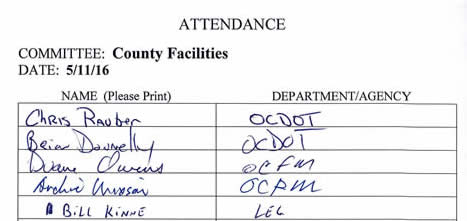
* * *
May 12, 2016
KATHLEEN A. RAPP, CHAIR
* * *
JOINT MEETING OF COUNTY FACILITIES AND WAYS & MEANS COMMITTEES
MINUTES – MAY 12, 2016
JUDITH TASSONE, Chair DAVID KNAPP, Chair
County Facilities Committee Ways & Means Committee
COUNTY FACILITIES MEMBERS PRESENT: Mrs. Tassone, Mrs. Shepard, Mrs. Rapp, Dr. Chase
MEMBER ABSENT: Mr. Dougherty
WAYS & MEANS MEMBERS PRESENT: Mr. Knapp, Mr. Jordan, Mr. May, Mr. Kilmartin, Mr. Shepard, Ms. Williams, Mrs. Ervin
Chairman Knapp called the meeting to order at 12:00 p.m. He said that he does not plan to call of a vote today, and Chair Tassone agreed. The meeting is to get an introduction as to priorities, answer some questions, have 12 -13 days to digest everything and take a look at it, and forward questions to OCC. It will come back to Ways and Means Committee to be considered.
1. ONONDAGA COMMUNITY COLLEGE: Dr. Casey Crabill, President; Mark Manning, CFO; Carol Obernesser, Assistant for Financial Svcs.
a. Adoption of Annual Budget for Onondaga Community College For the Fiscal Year September 1, 2016, to August 31, 2017, and Authorizing the Co. Executive to Enter Into Contracts with Other Governmental Units in which Appropriations and Revenues are Approved by the Adoption of the 2017 Budget
Dr. Crabill noted that the Hospitality Program is in the middle of renovations – 100% paid with SUNY 2020 funds. They will end up with and an enhanced kitchen, a bakery kitchen, retail space, revised Bistro – run by students.
Dr. Crabill provided the following:
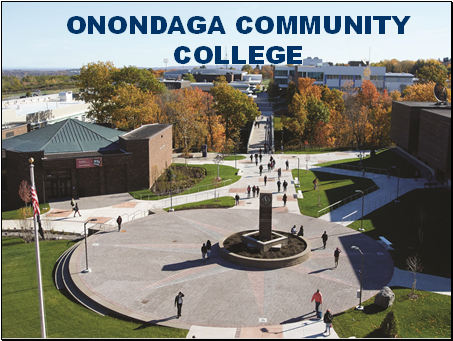
- Completed West Quad – capital project legislature provided funding for last summer
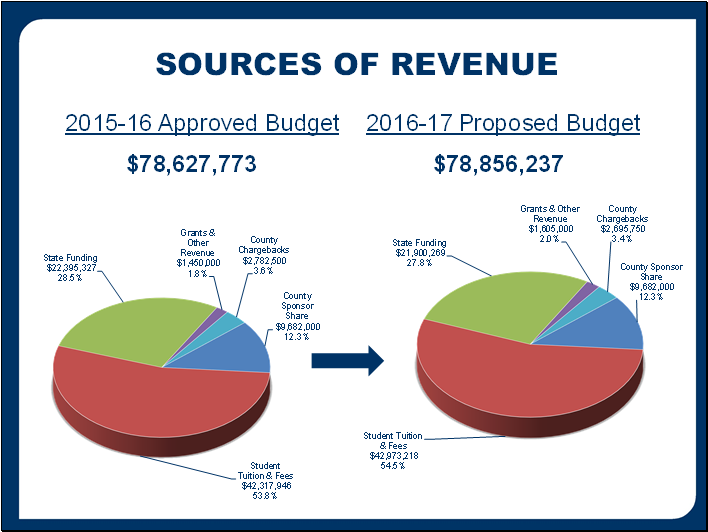
- Budget has been approved by Board of Trustees
- State Funding is going down
- Heard in state budget process that the funding was going up, but State funding is on a per full time equivalent basis
- Across the state high school graduating classes are smaller – college entry population getting smaller – known by the State
- State increased the amount per full time student, but still decreased the total on the state budget line for funding for community colleges
- Effect is $500,000 reduction to OCC
- OCC had a good sense that it would happen, so began the budget process in a framework of constraint
- Need to manage the decline in state funding to make sure to meet the needs of students
- County support proposal is the same dollar for dollar support as current year
- No increase in operating funds accomplished by:
- A look at every vacant position – started next year with net reduction of 7 positions
- Held back on equipment funding
- Savings in reduced utility costs
- Proud to be be able to do if next year with same amount of funding as this year
- $70 additional ask per student
- Doesn’t bring it near the cut off for TAP or Pell
- Students receiving state of federal financial aid will still have expenses fully covered
- Because the price went up a little, students receiving federal financial aid will get an addition $20
- Keep the access mission
Chairman Knapp asked how the tuition compares with neighbors. Mr. Manning said that that OCC is the 10th highest out the 30 community colleges. Dr. Crabill said they are in the bottom of the top third. Mr. May asked where OCC stands if the downstate schools are cut out. Dr. Crabill said that there aren’t any community colleges south of Westchester County. Most of the institutions are Poughkeepsie, north and west. The proposal is a 3% increase for students. Of the 30 community colleagues, projected increases get up around 7% and 8% because the smaller schools are having a more difficult time managing the state reduction than the larger schools. All 30 are projecting an increase, 3% is the lowest increase projected; most are 5%, and several are closer to 8%.
Mr. Jordan said there is a roughly a $230,000 increase in the proposed budget, and asked how much is anticipated to be generated from the tuition increase. Mr. Manning said that the increase in tuition, basically because of enrollment, is going down by a few hundred thousand. The increase in tuition revenue is driven by the Workforce Development enrollment. There are new programs coming on line – certificate programs, not credit bearing, and are included in the tuition fee. Dr. Crabill said a fee is charged for them because they don’t earn a credit, and they don’t have to have a high school education – it is just to train for the workforce. Mr. Jordan asked if the fee is going up. Dr. Crabill said that the programs are new next year, and are projecting the income from those fees as part of the tuition revenue. In answer to Mr. Jordan, Mr. Manning said that the revenue from tuition and fees has gone down $300,000 – the increase in the total is due to the increase of the Workforce Development. Dr. Crabill said that they are projecting the fees to come in at that level, but the operating budget is built around not spending it if it doesn’t materialize. Those programs, if not enrolled sufficiently, wouldn’t be offered. Chairman Knapp said that the projection is over a $600,000 increase based on the new programming fee. Mr. Manning said that about $200,000 of that is from the current high school enrollment. Dr. Crabill said that they get state aid for that, and the districts
Mr. Kilmartin asked how miscellaneous fees to students have trended over the years. Dr. Crabill said that they pay an activity fee, lab/science fee (if applicable), course materials – none of the fees have increased since the year before she became president. Housing fees and meal plan fees have stayed flat. The Housing Corporation subsidizes the purchase of the meal plan, so that it can be offered to students at cost. She explained that employed students have the opportunity to take a class and get a reimbursement on the tuition, but not fees. When talking to adult students, their preference is clear to increase the tuition and not the fees.
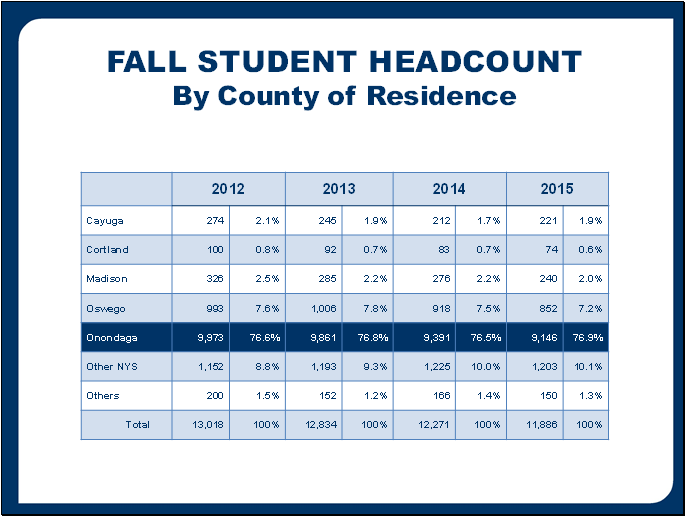
- Percentage of Onondaga County students is pretty consistent
- Great majority of students at OCC are from Onondaga and surrounding 4 counties
- About 10% of students are from New York, outside of the 5 counties; 1.3% from other – (one student from Minnesota, 48 students from other countries)
Chairman Knapp asked about the chargebacks. He noted that Cayuga is very disproportionate. Dr. Crabill said that their price is high. She explained that the formula is changing on how to figure out chargebacks:
- Next year the formula contemplates: sponsor share for operating divided by the number of Onondaga County kids that go to the school
- The current formula also contemplates kids from outside of the county
- The idea of the chargeback is to compensate for the sponsor contributions for kids coming in from another county, so that you are not paying the county portion for those kids
- Sponsor contribution over the number of kids sent renders a per head figure that is considered to be be the county support for each of those kids
- That dollar amount will be what is charged to counties for their kids, per the new formula
- Kids have to provide a certificate of residence from their county, collected in the Student Accounts office, and OCC invoices those counties based on the number of students who have proven that they are residents of those counties
- If student does not provide the certificate of residence from their county, then OCC cannot bill that county, but the student must pay double tuition, as does everybody else who comes from outside of New York--– the second dose of tuition is considered to be the fill in for what the county support would have paid
Mr. May said that the divisor is the number of Onondaga County students. Dr. Crabill agreed that it is; the new formula is more complicated – includes a little more revenue and a few more students, but the essence of it is charging other counties for what you provided for your students.
Mr. Jordan asked if, i.e. if our subsidy for each Onondaga County student is $2,000, then we are getting $2,000 from the other counties. Dr. Crabill agreed, and added that if we get a bill from Cayuga, it is going to be $2,200, and a bill from FIT is $11,000 per student. Each school has a different rate because it is based on that different relationship with the sponsorship and the number of students from that county. It is complicated. Part of it is the look back – using prior year data – can figure out what it is going to be. It used to be that you would look forward; the new formula makes you look back.
Mr. Manning said that if the legislation had been approved, the chargeback rate for next year would have been $1,625; this year’s chargeback is $1,630. It will help the chargeback rate for next year and bring it up to $1,700. Once it kicks in, the rate will be known well in advance, as it is taking it two years prior with the sponsor contribution per FTE. Right now with looking forward, they are making estimates, and there is a true up every year.
Dr. Chase asked for clarification. Dr. Crabill said that, i.e. if a student comes from Cayuga County, the students registers and pays the student tuition portion. If they prove that they live in New York, Onondaga County sends a bill to Cayuga County to make up for what Onondaga County pays for the Onondaga County student. Dr. Chase said that the student from Cayuga County is not paying more and then we are charging the county too. Dr. Crabill agreed and added that if the student is coming from, i.e. Minnesota, he/she pays double tuition, – there is no charge back to Minnesota. The idea is that the double tuition that the student pays makes up for whatever the support the county can provide.
Chairman Knapp referred to the chargebacks, noting that we pay them almost $1 million. Obviously, they aren’t supposed to cherry pick kids from out county – asked how we can fight this. Dr. Crabill said that she has been expressive about some of the processes in Cayuga, and to an extent Tompkins-Cortland, in terms of recruiting in our high schools. A gentlemen’s agreement exists, but they have found that Cayuga, in particular, was busing students from Onondaga County high schools to their campus to recruit them. She has put in objections to the Chancellor’s office on all of those practices. It says to her, that if we are losing 300 kids from Onondaga County to a school, then there are recruitment efforts that are being missed. In working on the strategic plan, they are talking about solidifying relationships with the high schools and making sure that the partnerships are clear and students have the opportunity to experience OCC in their junior or senior year. Give them a sense of what is expected in college; have an opportunity to take an English and math class -- get it on their transcript and never face placement testing and remedial forces anywhere they go, and building a bridge to the family so they understand the educational resources available at OCC. She would never encourage a student to choose another institution, unless OCC doesn’t have the program.
Dr. Chase referred to the 221 students from Cayuga, and asked if there is a look at where they live, i.e. Elbridge, Jordan, Skaneateles, where they are physically closer. Dr. Crabill said that the Jordan-Elbridge School District is split – some live in Cayuga County. However, that school district has done a lot of work with OCC and a lot of kids come from there. She said that 852 kids coming from Oswego will bother Cayuga County, as they have spent a ton of money building a campus in Fulton. It is a general education campus, and a lot of times students are looking for more specific programs. The applications from kids from Oswego is up 14% for next year. Chairman Knapp said that Oswego is open game, because they don’t have a community college.
In answer to Chairman Knapp, Oswego is included under “other colleges”. The communities listed are just those that have a community college - Onondaga County does not pay a chargeback to Oswego.
Dr. Crabill said that the Governor created Community College Councils to line up with the regional economic development areas, to encourage colleges to collaborate more. The council will be OCC, Cayuga and the Cortland half of Tompkins Cortland Community College. The president, a trustee, a faculty members, and a student from each institution will come together at least 3 times per year to make sure issue of completion are looked at, making sure money is not being spent on duplication, etc. It might help to get students more focused on the attending the schools that are already carrying them.
Chairman Knapp said that another valuable piece, already being done and can only grow, is the affiliated agreements with colleges. To show a student a very seamless path from high school to OCC, and then in the junior year report to ESF, St. John Fisher, SU, or Lemoyne, is a very powerful tool. Dr. Crabill agreed and said that they are seeing more interest in the four years. They are updating some of the agreements, including more programs, seeing more students coming in who are savvy about the programs - understanding that the 2 + 2 is available to them. There are great relationships in the region in with the four-year partners. The agreement with LeMoyne covers every single transfer credit that OCC has. SUNY Oswego is talking to them about an automatic admission. The competition for the kids in high school is really fierce.
Mr. Jordan asked what happens when the kids go on to LeMoyne or SU with these programs, do they pay the LeMoyne or SU tuition. Dr. Crabill said that they do. The only school that has a differential tuition for transfer students is ESF. In some of the programs at ESF, the students continue on from OCC and continue to pay OCC tuition.
Mr. Jordan referred to the headcount being down 9% - 10%; peaked in 2013/2015, and asked if that trend is envisioned to continue. Dr. Crabill said that in looking at the schools right now, the first grade that gets bigger is 3rd grade. The two things being worked on are growing the percentage of high school students that choose OCC. Right now OCC gets about 20% of the high school graduating class through the county. The national average is about 28% - will try to grow it to the national average. Also trying to make sure that students can see their way, all the way through, without stopping out. It is known that when students take a break, the chances of them actually finishing drops 30%. They are trying to get that information out; keep students in--keep them enrolled until they actually complete. It will have a side effect of supporting the numbers.
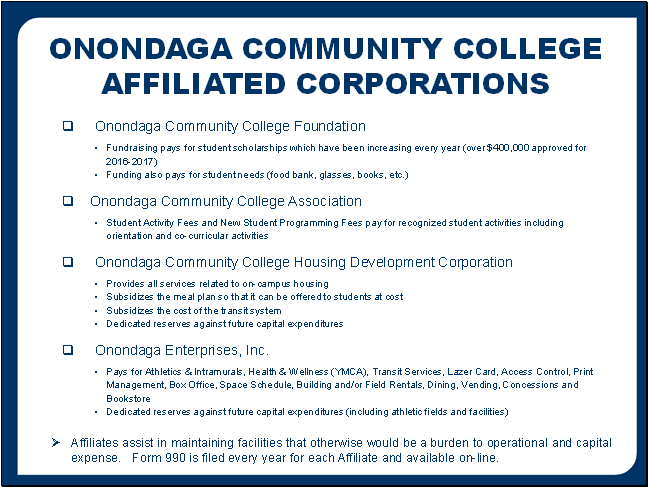
- Onondaga Community College Foundation
- Money raised throughout the community to support students and their education
- Also gives away about $200k in student needs
- Onondaga Community College Association
- All community colleges have this type of association
- Allows students to have the majority say in how their other activity and first time student fees are apportioned
- Housing Development Corporation
- Formed to build residence halls – carry the debt for that bond
- Hold dedicated reserve to ensure that no future capital costs for repair, maintenance, replacement of furniture, ever comes against the college’s budget
- Fully stand-alone funding source
- Onondaga Enterprises, Inc.
- Also manages all off OCC events that happen in college facilities, i.e. a business conducting training, Section III cheer competition
- Also pay for all the staff that does the dining, vending concessions, bookstore
- All of the services/programs they manage stay off of the operating budget
- They do the work, pay for the work and allowing the college to have them available
- All of the affiliates are independent 501C-3’s – all file 990’s every year – all of it is online
Mr. Jordan referred to page 1-16, noting that the fall to fall retention rate for 2013/14 at 57.4%, and in 2015/16 budget that number is shown 56.9%. Dr. Crabill said that retention rates refer to the students that were there in the fall of 2013 and came back in the fall of 2014. It is measured by fall to spring and fall to fall. Mr. Jordan questioned why a different number was shown in this budget. Mr. Manning agreed with Mr. Jordan – when they presented last year there was a different number. Ms. Obernesser said that they report in a period of time; by the end of the year the final report has shifted – there was a change in the number based on the reporting. Mr. Kilmartin said that there is a lag time for final reporting; Ms. Obernesser agreed. Dr. Crabill said that when a semester starts, there are programs operating with an amount of students enrolled in them. When the report is submitted, it will be a number and then two weeks later another session starts, some other students come in and they get caught later in a different report. Mr. Jordan said in the 2015/16 budget is it 2 years after that fall to fall period, in the other case it is 3 years – seems there would have been plenty of time to correct the numbers. Dr. Crabill said both numbers are accurate, but they were accurate because they were reported at different times of activity. With enrollment, they have to report on certain days and will get different numbers. If she takes the first fall to fall measurement on the census date at that beginning of the semester, and a student is in a program that starts in November, he isn’t retained for the fall until his program starts November. He isn’t counted in the September number because he isn’t there, but when you take the the fall to fall look back, he was there the previous fall. He then starts in the following fall in November, and he is there again. Mr. Jordan said that the 2011-2014 3-year graduation rates and 2011-2014 3rd year success rates, show differences. Dr. Crabill said that they don’t go back and change what was reported for the time periods they were supposed to measure and report them; they are caught up the next time the measurement is taken.
Mr. Manning explained, for example, fall of 2014 was last years, which ended in Dec. 2014; OCC came to the Legislature in May of 2014, and the final enrollment for SUNY wasn’t until August. Mr. Jordan said that he understands if it is a year or two later, but this is many years later and the numbers are still changing from one year to the next. Ms. Obernesser said that the fall 2014 are in both of those calculations. Mr. May said that in a perfect world we would be saying “this date 2008 to this date in 2011” and then annotate under that exactly where it stood from an enrollment standpoint. He referenced, for example, that in the financial world if the month closes on a Friday, everyone’s paychecks are in and the price is high; if they close on a Wednesday, people haven’t been paid yet and the deposits fluctuate with the time the measure is taken. Dr. Crabill agreed.
Dr. Crabill said that there are many entities looking at the numbers. SUNY has one lens, Feds have another, OCC participates in Achieving the Dream (group of schools working together to try to increase retention and completion), and they use another set of numbers. The numbers are drawn from the same database, but drawn on a schedule with a focus dependent on who is asking for the report.
Mr. Jordan referred to the projected chargebacks the county is receiving – some years show an estimated amount and then in subsequent years it is indicated that substantially more was received than budgeted, and he asked where the difference goes. Dr. Crabill said that they are guessing what the numbers will be and what the rate will be. Sometimes they over estimate and sometimes they under estimate; whichever way it goes, they manage to a balanced budget by the end of the year. That is the charge of the board.
Chairman Knapp said that the chargeback money that is received goes to a specific account. Dr. Crabill said that the college remits to the county $300 for each of the students, from their county. It goes directly to the county to offset debt service. Mr. Manning said that money does not get reported on the college’s side; they basically hold it in trust for the county and cut the checks twice a year to the county.
Mr. Jordan referred to page 2-17 – grant expenditures -- and questioned the consistent estimate of $12 million in grant funds every year – he asked if that amount is received. Dr. Crabill said that many of the grants are multi year. There isn’t a lot of estimating on the ones they know about. If successful in seeking a new one, they could be off. Mr. Jordan said that is never ends up being exactly $12 million. Dr. Crabill said there are actuals shown for 12-13, 12-14, 14-15, and the adopted number in 15-16. They assume next year will be fairly similar.
Mr. Jordan referred to grants and other sources - pg. 2-11. Mr. Manning said that is the percentage that they get of the grant to administration of it. That is not considered operating and not part of the college’s budget. Dr. Crabill said that grant funds can’t be comingled with the operating funds. It is requirement for receiving public dollars. They are able to get a portion of it to to support the operating of the grant – i.e. separate accounting, may need additional staff. Mr. Jordan asked if there is any other reference to grants coming in. Ms. Obernesser referred to page 2-15, which list the types of grants that they get. These are award amounts – in total $12 million, but not based on the expenditures. Dr. Crabill said that they have to be accounted for with the granting source and all of the audits.
Chairman Knapp said that there are two weeks to review the budget and come up with questions. He asked members to share their questions and answers with the other members. Dr. Crabill said if anyone wants to go through it individually, she will be available and have her finance team available. In answer to Mr. May, Dr. Crabill said that questions can be sent to her, and she will make sure the right people help get the answers.
Chairman Knapp asked how the Onondaga Community College Foundation raises its money. Dr. Crabill said that they do classic fundraising – have an annual campaign. There are a lot of donors – alumni, companies, etc. With the $400k given out, a lot of it is matching the criteria of the donor to the right student.
Chairman Knapp asked what the rules are for being able to dip into the affiliate corporation fund for use in operating. Dr. Crabill said that it is totally against the rules. If the college has a need and wants to suggest that OEI fund the need, then a formal proposal is made to the OEI Board. They decide if appropriate and can say yes or no.
Mr. Kilmartin said that this is a great budget, being flat considering costs are going up in different operations of the college. He knows the college focuses on reducing the bottom line and expenses, which is not easy in this environment. Mr. May agreed and thanked Dr. Crabill for providing the statement for the affiliated corporations; it is very helpful.
Chairman Knapp asked Dr. Crabill to provide information on the police academy. Dr. Crabill said that the Sheriff has relocated the academy back to OCC. Dave Wall is the new Director of Public Safety. As soon as he got the positions he asked if he could have a conversation with the Sheriff, as he wanted to bring the academy back. Within about two weeks the cadets were on campus. It is great for them with having the arena use; there are classrooms dedicated to them, seeing the training up close is good for the students. In answer to Mr. Jordan, Dr. Crabill said that the City has not moved to the campus, but there have been some good conversations with the Chief. He is interested in the continued education for the SPD. Chairman Knapp added that there is transition going on in the city with the announcement of his retirement. Mr. May said that he was at the graduation, which was packed – multiple counties were present – the education process included several counties, and there were multiple County Sheriff’s present. He estimated that one third of the graduates were form other counties. It was a great ceremony.
Dr. Crabill said that the Sheriff is working on on making the training available pre-employment. Folks can go through the training all the way up to the firearms piece. They then present themselves as much stronger candidates to the municipalities. Students have footed the bill for it, so it saves on training costs of the municipality.
Mr. Jordan said that it doesn’t make much sense to have two academies. Mr. May said that correction officers were included also. Mr. Kilmartin said that Sheriff Conway’s dovetailing the training for custody and patrol officials is making it more efficient for the students, the educators, and saving time and money. Mr. Kilmartin said that a number of years ago, he had worked to try to get the city and the county to come together in a common facility. There is a lot of territorial anxiety with it, but the fact that here are so many different agencies at the college doing that and one outlier, speaks at the momentum going forward and the opportunity for the outlier. Dr. Crabill said that will work hard to get it and will keep that door open, as it is good for the students to have that exposure and opportunity.
Chair Tassone clarified for the record that the reason the County Facilities Committee did not vote for the $4.9 million bond, which Facilities Management is asking for, was because there was one question that needed to be answered yesterday. Mr. Owens provided wonderful information, and it is going right to Ways and Means Committee. Mrs. Rapp said that Mr. Carr helped clear it up as well at Planning Committee today.
The meeting was adjourned at 1:05 p.m.
Respectfully submitted,

DEBORAH L. MATURO, Clerk
Onondaga County Legislature
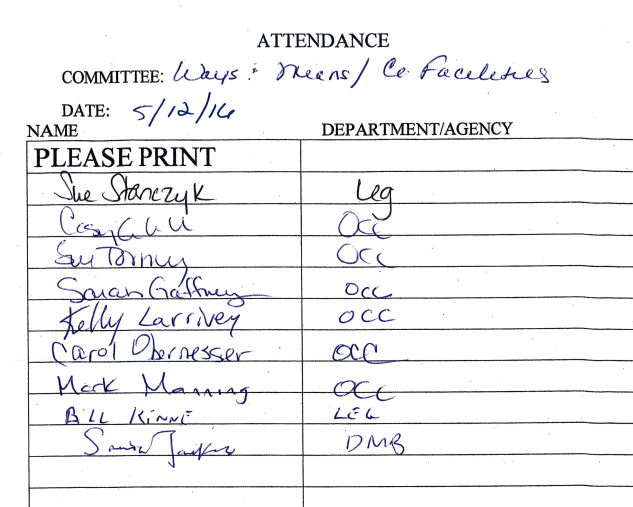
* * *
WAYS AND MEANS COMMITTEE MINUTES – May 23, 2016
David Knapp, Chairman
MEMBERS PRESENT: Mr. Shepard, Mr. Jordan, Mr. May, Mr. Kilmartin, Mrs. Ervin, Ms. Williams
ALSO PRESENT: Chairman McMahon, Mr. Ryan, Mr. Fisher, Mr. DeMore, see also attached list
Chairman Knapp called the meeting to order at 9:20 a.m. A motion was made by Mr. Kilmartin, seconded by Mrs. Ervin, to waive the reading of the minutes of the proceedings of the previous committee. MOTION CARRIED. A motion was made by Mr. Kilmartin, seconded by Ms. Williams, to approve the minutes of proceedings of the previous committee. MOTION CARRIED.
1. TRANSPORTATION: Brian Donnelly, Commissioner
a. Amending the Design (Scoping I-VI) and Right-of-Way Incidentals Phase of Allen Road (CR 205) Paving Project, PIN 375461 by $100,000, and Increasing the Authorization to Pay in the First Instance 100% of the Federal Aid Eligible Costs by $80,000 ($80,000)
Items 1a and 1b – pay in the first instance for federal aid projects
- Item 1a – additional design work for Allen Road – originally just a paving project; adding sidewalk from Taft Rd to the elementary school, replacing deteriorated metal pipe underdrain; Phase B1 Archeological Report done – an archeologist reviews sites
Chairman Knapp noted that item 1a and 1b passed County Facilities Committee unanimously.
A motion was made by Mr. Kilmartin, seconded by Mr. Jordan, to approve this item. Passed unanimously; MOTION CARRIED.
b. Amending the 2016 County Budget to Fund in the First Instance 100% of the Federal Aid Eligible Costs at a Maximum Amount of $260,000 for the Design (Scoping I-Vi) and Right-of-Way Incidentals Phase of the Old Route 57 Paving Project, PIN 3755.82, and Authorizing the County Executive to Enter into Agreements to Implement the Intent of this Resolution ($260,000)
- New federal aid project - design for paving Old Rt. 57 from Caldor Court to Rt. 31, approx. ¾ mile
In answer to Chairman Knapp, Mr. Donnelly said that design is 80% federal, 20% local. Construction is 80% federal 15%, state, 5% local. County has to pay $260,000 and will get 80% reimbursement. The local share was appropriated in the 2016 plan
A motion was made by Mr. Jordan, seconded by Mr. Kilmartin, to approve this item. Passed unanimously; MOTION CARRIED.
2. COMMUNITY DEVELOPMENT: Robert DeMore, Director
a. Authorizing the Cancellation and Discharge of Real Property Taxes on Property Owned by the Onondaga Housing Development Fund Company
- 120 Charles Avenue, Solvay
- Last year asked for forgiveness of county taxes on the 200 block of Charles Ave
- Normally pay tax bill in January – this tax bill is $12,000 – mostly village tax - village charged for maintaining property (rats on property and mowing)
- Estimate that it can be fixed for $120k, first bid came in at $160k, which was rejected – will rebid it
- Money available from other grants; will have about $100,000 out of pocket; can sell for $120k
- This will save $12k that won’t have to pay back with County money
- This is one time deal – won’t come back for more properties
Chairman McMahon:
- Consistent with Solvay revitalization effort
- Took title on monstrosity on Charles Ave, across the street, which was knocked down
- This will rehab the property and keep the density; where houses were knocked down, new houses will be built--this is a key property
- Community Development is a great tool to make sure properties are developed properly
- It is paying out of the left pocket or the right – coming from the county to pay the county
In answer to Mr. Kilmartin, Mr. DeMore said that after it is developed the property will be sold. Someone will will live in one unit and rent the other out – owner occupied.
A motion was made by Ms. Williams, seconded by Mrs. Ervin, to approve this item. Passed unanimously; MOTION CARRIED.
3. BOARD OF ETHICS: Bill Fisher, Deputy County Executive
a. Confirming Appointment to the Onondaga County Board of Ethics (Dennis DuVal)
- One member has to be a county employee – Ms. Primo is the nominee
- Mr. Duval – service to Syracuse Police Department, S.U. Community, community at large
- Resumes in packet
A motion was made by Mr. Kilmartin, seconded by Mrs. Ervin, to approve this item. AYES: 6; NOES: 0; ABSTENTIONS: 1 (May). MOTION CARRIED.
Chairman Knapp clarified the Mary Beth Primo is replacing Ann Rooney on the Board.
4. HUMAN RIGHTS COMMISSION: Bill Fisher, Deputy County Executive
a. Confirming Appointments to the Onondaga County/Syracuse Commission on Human Rights (Shiu-Kai Chin, Joyce M. Suslovic, Rev. Douglas P. Mackey, Francis M. Parks, Leonardo L. Sanchez, Mary Alice Smothers, Suzette M. Melendez, Rev. H. Bernard Alex, Bruce Carter, Rabbi Daniel J. Fellman, Starr L. Guckert, Gabriel Ramos)
- 12 appointments submitted by County Executive
- Terms vary – staggered
- County Legislature has 6 recommendations, confirmed by the County Executive
- Mayor has 6 appointments
Chairman McMahon noted that next month more appointments will be made.
A motion was made by Ms. Williams, seconded by Mrs. Ervin, to approve this item. Passed unanimously; MOTION CARRIED.
5. COUNTY CLERK: Lisa Dell, County Clerk; Chris Plochocki, Deputy County Clerk; -
a. Mortgage Tax Apportionment
Mr. Plochocki:
- $3,958,177.15 total
- Down 8% from previous period; up 21% from same period last year
A motion was made by Mr. Kilmartin, seconded by Ms. Williams, to approve this item. Passed unanimously; MOTION CARRIED.
b. A Resolution Authorizing the Replacement of Software and Hardware at the County Clerk’s Office in and fore the County of Onondaga, NY at a Maximum Estimated Cost of $600,000, and Authorizing the Issuance of $600,000 Bonds of Said County to Pay the Cost thereof
Ms. Dell:
- Evaluating vendors now to determine the best choice
- The first year there is an initial cost
- If approved, it will take to the end of the year before the system is live
- Maintenance cost will occur in the following years
- Generating revenue to help pay for it
Mr. May referred to the revenue generated and noted that the forecast provided an aggressive payback schedule. Ms. Dell agreed and noted that she can’t say how much revenue it would generate this year. She said if this goes through, there will be press releases, reaching out to law firms and title companies to let them know about it.
Mr. Shepard asked if there is an idea of how much a subscription to it will cost. Ms. Dell said “no”, because in speaking to other county clerks, the range is all over. Once a vendor is in, we will see what is best for the community. Generally, a lot of county clerks charge 50 – 55 cents per page, 55 cents is the statutory limit for a copy. Subscriptions rates vary – out of state is more; in state is less. On top of subscriptions, you would still pay per copy; subscriptions are done for the convenience.
Chairman Knapp does not see a downside both from a payback and service to the community. Even if it was break even, he wants to do this for the service to the community.
Chairman Knapp said that last month there was discussion about the CFO paying cash at the end of the year, if it is available, or bonding for it. The current resolution is for bonding only, and asked how the option to pay cash can be addressed. Mrs. Berger advised that the resolution can be approved in concept today, and she will check with bond counsel about adding the language. Chairman Knapp asked members if there was any objection to that, with the change being made for session. Hearing none, he asked for a motion.
A motion was made by Mr. May, seconded by Mr. Kilmartin, to approve this item. Passed unanimously; MOTION CARRIED.
6. FACILITIES MANAGEMENT: Duane Owens, Commissioner
a. A Resolution Authorizing Design Expenses in Connection with Improvements to Public Facilities in and for the County of Onondaga, New York, at a Maximum Estimated Cost of $550,000, and Authorizing the Issuance of $550,000 Bonds of Said County to Pay Costs Thereof ($550,000)
b. A Resolution Authorizing the Construction of Improvements to Various Public Facilities, in and for the County of Onondaga, New York, at a Maximum Estimated Cost of $4,969,000 and Authorizing the Issuance of $4,969,000 Bonds of Said County to Pay Costs Thereof ($4,969,000)
Items 6a and 6b were discussed simultaneously.
- Bonding for continuation of capital projects at downtown campus
- Civic Center – ongoing project office and masonry improvements: masonry repairs lower brick veneer and stem walls of columns, office and interior renovation on various floors – new office environments, painting, lighting, carpeting, HVAC modifications, ADA enhancements
- 2016 requesting construction money to to continue projects mainly on the 7th and 8th floors; 6th floor is 65% complete
- Timing is important to the bidding process – asking for construction money before work begins
- Downtown Various Capital projects:
- Structural integrity, mechanical systems, energy efficient systems – vital to life/safety of facilities
- Ongoing projects – since 2011
- Asbestos removal; sidewalks have to be done after every winter, Terrazzo flooring in vestibules, steam traps
- Oncenter Rehab:
- Project began in 2012 – asked for $1.5 million at $500k/year on capital projects that are vital to infrastructure
- Requesting another $1.5 million at $500k/year
- Enhance War Memorial marquee –
- Interior work in conventions rooms
- Forensic Science Building
- Interior and exterior projects – repair and renovations – several will provide safety and more functional work space
- $150,000 request for engineer and design study for some of the reconfiguration to be done
- $150k engineering/design at forensic center
- $400k to study HVAC in old court house – project on everyone’s radar for some item; sticker shock on initial price– felt the cost can be reduced dramatically with an engineering/design study; possibly re-utilize some of the components of the system
Chairman Knapp clarified that item 6a is only for the two items ($150k engineering/design at forensic center and $400k to study HVAC in old court house). Item 6b, $4,969,000, is for all of the projects outside of the design. Mr. Owens agreed; $4.9 million is for the construction costs. Chairman Knapp explained that the items went through County Facilities Committee; no vote was taken, but Chair Tassone had noted that the joint meeting on May 12th, that Mr. Owens provided information and the committee was in support of the projects.
Mr. May said that these are all good projects and make sense – routine maintenance and investments where they may provide a return. He is inclined to ask for the item to be tabled, but will abstain from voting instead. The caucus had agreed to have a process with capital projects where the requestor comes in initially and presents items informationally. It can then be digested, questions can be asked, and members can be comfortable when they take a vote. That process didn’t happen here. He has held to the policy and Ms. Dell and Mr. Bleyle have been subjected to it. The policy will help legislators make good decisions, and he intends to stick with it within the committees he has responsibility for. Chairman Knapp agreed.
Mr. Jordan referred to asbestos removal and understood that it is not really a problem unless it is disturbed. To the best of his knowledge, there hasn’t been any issues or disturbance of asbestos, especially in the tunnels; and questioned if it is something that has to be done or something we’d like to have done, noting the cost of $350,000. Mr. Owens said that after during routine maintenance they discover and disturb asbestos, i.e. lifting ceiling tiles can disturb it. Bathroom stalls contain asbestos, and have to provide asbestos abatement process to repair them. Mr. Wixson provided another example and noted that it is not one particular abatement project, it is broad based. In the tunnel, sections of asbestos have to be removed in order to get to the steam valves/traps. Mr. Jordan asked if it is for asbestos removal where other work is being done. Mr. Wixson said that it is. Mr. Owens said that often it is just during routine maintenance.
Mr. Owens noted that the severe leak in the tunnel, above the door, from the garage, is being fixed right now.
A motion was made by Ms. Williams, seconded by Mrs. Ervin, to approve items 6a. AYES: 6; NOES: 0; ABSTENTIONS: 1 (May). MOTION CARRIED.
A motion was made by Ms. Williams, seconded by Mrs. Ervin, to approve item 6b. AYES: 6; NOES: 0; ABSTENTION: 1 (May). MOTION CARRIED.
7. PERSONNEL: Peter Troiano, Commissioner
a. Reclassify RP 01 107110 1950 Employee Benefits Claim Clerk, Gr. 8, $42,745 - $47,262 to Employees Benefits Specials, Gr. 30 $47,686-$63,215
- Claims haven’t been processed in the Employee Benefits Division in 15-20 years
- This position was 1 of 6; this is the last one – appropriate to reclassify at this time
- Work the person performs is appropriately classified as an Employee Benefits Specialist
Mr. May asked if this has anything to do with the manager that retired. Mr. Troiano said that it does in part; it puts focus on this job. Without the employee benefits manager, this person has picked up a small amount of the duties and he picked up the rest. This allows focus on the current work, even without the manger there – it is not a claims clerk position any longer. It is an employee benefits specialist position in terms of day-to-day activities on plan maintenance, working with TPAs, addressing difficult problems of plan members, keeping track that the flow of work is done appropriately. In answer to Mr. May, Mr. Troiano said that the position did not have anything to do with safety and claims mitigation.
Chairman Knapp asked if the manager position will be filled. Mr. Troiano said they are in the process; a test was given at the end of April, and are waiting for the results of the list. He and others have picked up the responsibilities.
Chairman McMahon asked if the the department will make up the salary cost increase and questioned why the other position isn’t being abolished. Mr. Troiano said that they have salary savings in their budget to absorb the increase this year. The employee benefits claim clerk positions could be abolished, but by keeping it in the salary plan it is saves coming back and recreating it if circumstances change. Chairman McMahon said that he thinks the positions should be abolished. Mrs. Berger clarified that it is just one position; it is a reclassification of one position. Chairman Knapp said that in essence the position is being abolished, as it will no longer exist. Mr. Troiano said that it is one position – just changing the title and pay grade.
A motion was made by Mr. Kilmartin, seconded by Ms. Williams, to approve this item. AYES: 6; NOES: 1 (Jordan). MOTION CARRIED.
8. EMERGENCY MANAGEMENT: Dan Wears, Commissioner
a. Transfer from Emergency Management, Acct. 666500 Contingency, to Emergency Management, Acct. 694010 Travel and Training, $10,000
- Contract with OCC to deliver Public Safety Critical Management course, to be held in the fall and spring
- Offered free to county residents, first responders, and support organizations including public sector
- Course – about integration of different disciplines during a large scale incident
Chairman Knapp said that he has been personally involved in it; it is a very popular course at OCC for the 57 volunteer fire departments. It sells out every class; OCC dropped it for a time, but has worked out a way to bring it back. Mrs. Tormey said that last year the OCC Foundation supplied some initial monies to keep it going. It is very popular - about 25-30 per class. It covers a whole gamut of first responder operations. No tuition is charged for the class.
Mr. May recently met with a large group of people in Lysander, and this was discussed. The context of some of the discussion was about shared services. This is another nice, quantifiable add to what the county is bringing to the community as critical incident management, public safety, and helping first responders do their job right.
A motion was made by Mr. Kilmartin, seconded by Mrs. Ervin, to approve this item. Passed unanimously; MOTION CARRIED.
9. WATER ENVIRONMENT PROTECTION: Tom Rhoads, Commissioner
a. A Resolution Approving Proposed Improvements for the Onondaga Co. Sanitary Dist. Consisting of the Rehabilitation of the Westside Pump Station in and for the Co. of Onondaga, NY
b. A Resolution Authorizing the Issuance of $16,550,000 Bonds of the County of Onondaga, New York, to Pay Costs of Improvements for the Onondaga County Sanitary District, Consisting of the Rehabilitation of the Westside Pump Station ($16,550,000)
Items 9a and 9b were discussed simultaneously.
- Westside Pump station – little building on Exit 7 off of Rt. 690, near Honeywell Visitors Center
- Over 40 years old; full of mechanical and electrical equipment
- Service area: lakeside to Village of Camillus, to Village of Solvay, Town of Geddes and most of Town of Camillus
- 2nd largest pump station and in need of distinct upgrade
- Numerous raw sewage overflows to Onondaga Lake during wet weather capacity issues
- On a dry day it runs 6-10 million gallons a day
- During extraneous flows, heavy wet weather, all of the old sewers in the towns’ and villages’ systems, in this service area, contribute the extraneous flow. It peeks out at 30 million gallons
- New station will be designed to manage over 40 million gallons/day
- Asking for support to upgrade the pump station, install larger pumps, replace electrical equipment and emergency generators, add in odor control systems
- Bring conveyances that contribute to it, or allow hooking into Honeywell force main, to bring it up to speed to: rehabilitate the pump station to ensure wastewater capacity for future economic growth; modernize to add capacity and odor control; reduce or eliminate raw, illegal overflows to Onondaga Lake during wet weather conditions
- Averaging about 2 overflows/year; keeping DEC informed on the project to avoid consent judgments and notices of violation
- If not able to accomplish this, would expose the county to daily damage up to $37,500/day for discharge of raw sewage to the lake
- Project cost $18.15 million; have $300,000 cash; have past bonding for the engineering portion
- Asking for $16.55 million
- Public hearing will be held prior to the June session
Mr. Rhoads reviewed some questions that he received from legislators:
- Has consideration been given to moving pump station to another location? - alternative locations were evaluated, but cost estimates ranged between $41.5 - $36.8 million – cost prohibited to relocate; will be doing a comprehensive rehab for about half of the investment of the proposed relocation spots
Mr. Jordan asked, with cost considerations aside, would the rehabilitation of the existing pump station be the preferable course or would it be better to relocate the pump station. Mr. Rhoads said that they would recommend rehabilitating it in full at the current location. It’s not cost effective to move it and will be able to provide an asset, which will have at least a 20 year life. Mr. Jordan asked why the relocation was proposed if it wasn’t a preference. Mr. Rhoads said that one reason was to “build one of these in the dry.” When building or reconstruction pump stations, there is significant cost in doing bypass pumping. While this is being built, there will still need to be available capacity for 40 million gallons/day of pumping around the station. At the time, it was thought that by building in another location, that bypass pumping would need to be done, but alternative locations had conveyance costs that became extreme. There was also potential for significant cost associated with contaminated real estate.
In answer to Chairman Knapp, Mr. Rhoads said that parts of it were built in 1959, according to O’Brien and Gere. It was upgraded once; will be reusing the wet well – underground concrete well that holds the sewer. Pretty much everything above ground will be replaced.
Mr. Rhoads:
- Small portion of Baldwinsville/Seneca Knolls area – convey through westside
- Design is to enable the economic aspects for Baldwinsville/Seneca Knolls area, which was seeing some concerns with BOD
- NYS Fair adds 100,000 people to the population
- Unique asset – making sure it meets all needs for economic development and serves the environment
Mr. Rhoads continued with the questions from legislators:
- What are you going to be doing? Will be replacing all structure elements – roof, siding, concrete, line wet wells,
- This pump station receives sewer from Camillus Pump Station (old Village of Camillus Wastewater Treatment Plant). The sewage is 2 days old by the time it arrives and it gets sulfurous. Hydrogen sulfide grows inside the sewer and causes tremendous corrosion problems – creates sulfonic acid
- All durable equipment needs to be replaced, specify new materials – many stainless steel, coatings
Mr. Jordan asked if something is being done to prevent that in the future. Mr. Rhoads said that they have a chemical injection and are looking at different types. The type used in the past is very corrosive. He will come back later this fall with a capital plan to replace portions of the Camillus force main.
- Will this last 20 years? Yes, it is being designed to last at least 20 years – the standard in the industry. The single largest risk is that the I&I will continue to grow unabated.
- 72% of capacity is designed to support extraneous flow – biggest risk is that towns and villages don’t stop the hemorrhaging coming into the pump station
- It erodes capacity for serving economic development and new subdivisions in the area
- Dire need to continue working with municipalities to preserve their capacity and not send us clean ground water and storm water
Mr. Jordan asked if municipalities qualify for EFC to deal with I&I. Mr. Rhoads said that they could apply for grants, but they are few and far between. There are several municipalities that could get zero interest loans, but they only want grant money.
Chairman McMahon said that the county has been doing suburban green infrastructure and will probably consider another run of that later this year.
Chairman Knapp asked if Camillus identified some of the areas. Mr. Rhoads said that they work with all of the towns and villages to try to identify for them and put together a capital improvement plan of priority projects. They need to then step up to the plate.
Mr. May asked if these resolutions have gone to program committee informationally initially and then voted upon separately. Mr. Rhoads said that they have.
Mr. May said that originally $15m was part of the whole west side/western shore revitalization project. He asked if by rehabilitating the existing station, is it necessarily accomplishing the increased capacity that many of us, particularly those along the western shore of the lake and northwest of there, have talked about as a direct benefit of this project. Are we solving it or setting ourselves to solve it. If so, and the price has gone up, what is being done to fix it elsewhere. The source for this work is the rate payer. Mr. Rhoads said that there was a larger discussion about the $100 million investment in the west side; this $15 million project was already a rate payer supported piece of work. Mr. May agreed, but said that now it is $18.1 million, and it sounds like this initial move won’t provide capacity; it will create the infrastructure to do it down the road. Mr. Rhoads agreed. Mr. May said that the cost has gone up and asked what is being done to alleviate the cost to keep the $15 million component within $15 million.
Chairman McMahon said that initially there was a $100 million west side revitalization plan; an amphitheater project $50,000; revitalization of Solvay $30 million; $500,000 Oneida gaming money, and this was budgeted originally at $15 million. He thinks Mr. May is saying that it is now over budget and asked if the county is going after EFC grants, are we working with federal partners. One of the strong goals of this project was to re-divert capacity and BOD from the Seneca Knolls facility. It is very important because many of the economic development potential sites currently go into that are, i.e. Radisson. He asked what it is going to cost to re-divert the capacity. Mr. Rhoads said that as part of this work, his understanding was that they would do the engineering. He is not sure they ever committed to doing the construction work. The engineering portion included upgrading the Baldwinsville Seneca Knolls Interstate Island service area and pointing in a different direction, through Lakeside Pump Station and Lakeside Trunk sewer. All of that work is approximately a $3.3 million capital project, which they have in the capital plan and will be bringing that forward. Chairman McMahon said that in the capital plan already are upgrades to Seneca Knolls – it ties in. With some of the grant opportunities, the county may be better positioned to get a grant from the State than a small town or village – what can be done to help the lobbying efforts; anything that we can do to get the number down to closer to $15 million is important.
Mr. May said that the entities driving the $50 million piece, the infrastructure piece, need to get at the table and say “this is different, what are we going to do”. Mr. Rhoads is the messenger and is fixing it or replacing it. Mr. May said he is half hearing that this isn’t going to cost $15 million to do this; it is going to cost $21 million. Mr. Rhoads is not sure that $15 million was ever a commitment to the physical work. Mr. May said that he would like to table this, as it needs to be sorted out. Mr. Rhoads cautioned that we are at risk when there is a heavy rain, raw sewage will be discharged into Onondaga Lake. There are a lot of things going on: Honeywell Visitors Center; State Fairgrounds improvements, tremendous amount of infrastructure that this project supports. We expose ourselves to violations of the State, which have significant financial penalties. Costs are rising significantly in the construction industry.
Mr. May said that he is not questioning the need to do this, nor the need to do it as soon as possible; he is not suggesting not doing it. He is suggesting that there was a commitment to spending $15 million to accomplish certain things and wants to make sure we do that or have a full understanding why we are not.
Mr. Jordan said that if part of the risk is the development at the fairgrounds, creating more demand on the facility, then perhaps the state should be kicking in some money. Mr. Rhoads said that there are paddock areas and camping areas that are state fair infrastructure that are being improved. Hopefully, it will reduce some of their extraneous flow. They are making their investments. A piece of this work involved lining some of the sewers on Milton Avenue, in the Village of Solvay, which was not part of the $15 million. There are smaller pieces of this extraneous flow that are being put together.
Chairman McMahon said that the goal of the project was to create capacity to Seneca Knolls, for economic development purposes. When we get into large projects, things change. There is a new REDC application going on right now – would like to see us put in an application, talk about this project and what the cost is going to be for implementing the physical work. Then, continue to look for other sources. There are economic development goals and environmental goals in doing this. To Mr. May’s point, part of the overall western revitalization project included that goal, so that project cannot be deemed a success until that is accomplished also. Mr. Rhoads said that they have applied for EFC funding on the project.
Chairman Knapp said that he is not 100% sure where the original $15 million number came from, if it was an estimate. He supports the project 100% but feels we should wait 30 days and do our due diligence. If there is a way we can find some dollars anywhere else and save the rate payers from taking the whole hit is a win. Mr. May said that he feels that is possible because the other part of this is largely cosmetic. There is an opportunity to bring this in line and do the things that we have to do.
Mr. Capozza said that he put together the $15 million proposal. This project was in the original capital plan going back to 2003/2004. As the plans developed, the number they heard was around $13.7 million. The project number came out at $15 million, excluding the northwestern conveyances portion of the project. He is not sure how that was rolled into the mix after. He would have probably inflated the number a little more if he knew that this number would have had this much gravity. Also, this is really being constructed in a Superfund site, and that is where we are seeing some of the moving of that number.
Mr. May said that helps him get from $21 million back down to $18 million, but it is still $18 million. Because the other side is largely cosmetic, to re-introduce that land into useful purpose, he believes something can be found to move forward with what has to be done.
Chairman Knapp said that the item will be held off for a month.
10. ONONDAGA COMMUNITY COLLEGE: Mark Manning, CFO
a. Adoption of Annual Budget for Onondaga Community College for the Fiscal Year Sept. 1, 2016 to Aug. 31, 2017, and Authorizing the Co. Executive to Enter into Contracts with Other Governmental Units in which Appropriations and Revenues are Approved by the Adoption of the 2017 Budget
Ms. Tormey delivered a message from Dr. Crabill, who asked for the committee’s indulgence, as she could not be present today due to her daughter’s graduation out of town.
Mr. Manning noted that Dr. Crabill presented the budget a couple of weeks ago at the joint meeting. They are here today for the adoption of the budget and maintaining the sponsor contribution of $9,682,000, which is the same as last year.
Chairman Knapp said that the county’s contribution is flat; the state’s contribution went up a little per student, but is down over all as result of enrollment. A tuition increase is proposed for $70 per semester.
Mr. Jordan asked if the received state and federal aid factors in the number of in county vs. out of county, and out of state, and out of country students. Mr. Manning said that it is all state aid, and it is based on full time equivalents. All of the credit hours that are eligible for state aid are divided by 30 and that becomes the FTE. That comes from all sources, whether out of state, out of county, or in county. Mr. Jordan said that the state is essentially subsidizing the out of state and out of county students. Mr. Manning agreed, and added that they don’t get a lot of students from out of state.
Mr. Jordan referred to debt service costs, i.e. capital projects like SRC Arena, dormitories, and asked who pays for the debt service. Mr. Manning said that they need to get the sponsor to agree for basically any capital cost at the college – 50% comes from the county and 50% comes from the state. The county will typically bond for their share of the capital that they commit to. Mr. Jordan asked if the bonding costs are reimbursed by the college in any way. Mr. Manning said that they aren’t. He added that the college collects $300 per FTE for capital chargebacks for any student that comes from outside of the county. It is about $500,000, which is remitted to the college and then paid to the county to help with the debt service.
Mr. Jordan pointed out that the annual budgets reference that the endowment by 2016 is anticipated to be $11 million, and asked how much it is so far. Mr. Manning said that the Foundation’s endowment is about $10 million.
Mr. Jordan asked about the OCC revenue offset to expenses, page 3-3. Mr. Manning said that they are various revenue sources: chargebacks from affiliates, rental income that comes in for higher education. Mr. Jordan asked if it revenue from other colleges. Mr. Manning said that there some rental agreements – St. John Fisher, Empire State, which operates on weekends and nights.
Mr. Jordan asked about refunds of prior year expenses. Mr. Manning said they are various items, i.e. if they have bad debt, then collect on it, then they write it off. They have a Medicare Part D reimbursement that comes in and it is recorded as a revenue – refund of prior year.
A motion was made by Mr. Kilmartin, seconded by Mrs. Ervin, to approve this item. AYES: 6: NOES: 0; ABSTENTION: 1 (Jordan). MOTION CARRIED.
11. PURCHASE:
a. Revenue Contract Report – NO SUBMISSION
The meeting was adjourned at 10:40 a.m.
Respectfully submitted,

DEBORAH L. MATURO, Clerk
Onondaga County Legislature
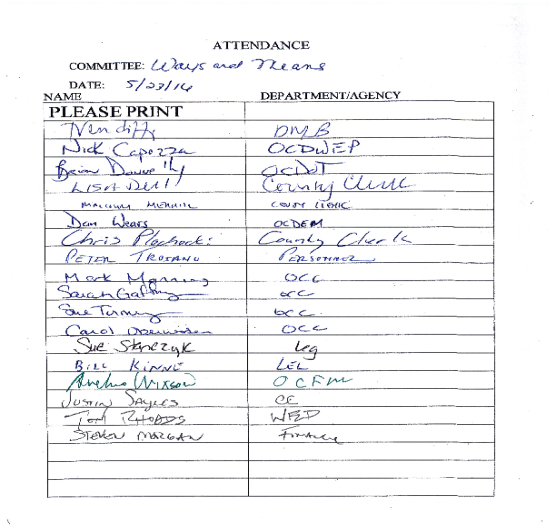
|

















































